Modern Painters, Vol. 1, No. 1
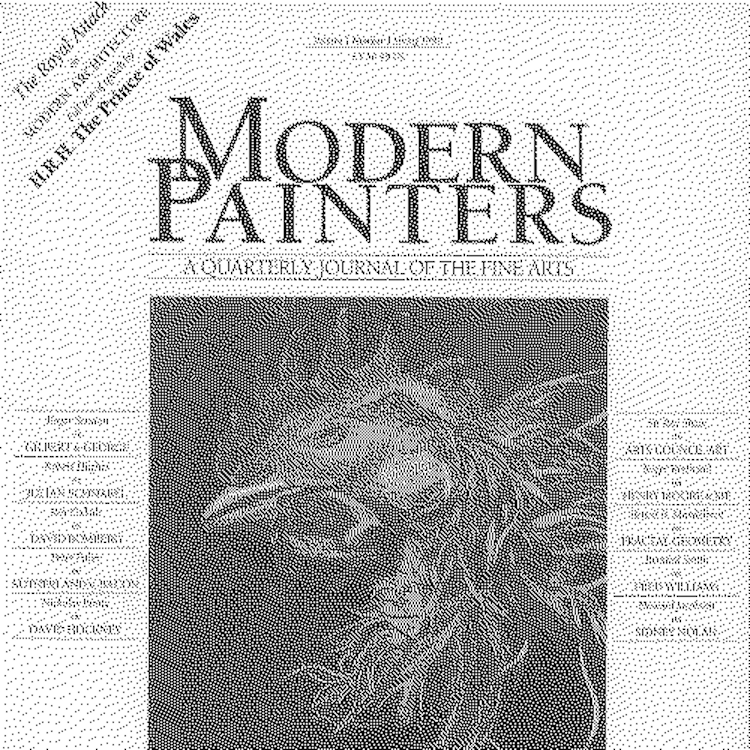
-
Chloë Julius
-
Stephen Moonie
-
Karen Di Franco
-
Moran Sheleg
-
James Baggott-Brown
-
Kevin Lotery
Introduction by
-
Chloë JuliusLeverhulme Early Career FellowUniversity of Nottingham
Introduction
In 1988 a new quarterly journal was launched to intervene in what its editor considered to be the “depressing orthodoxy” saturating British art and criticism.1 That journal was Modern Painters (fig. 1). The editor was Peter Fuller, an ex-Marxist art critic whose renewed faith in the beautiful and the transcendent had caused him to renounce John Berger as his teacher and claim John Ruskin instead. The substitution had been formalised by Fuller’s 1980 essay Seeing Berger, which took aim at the television series and book Ways of Seeing for what he perceived to be its “anti-art” position.2 Particularly troubled by the continued and sustained popularity of this position, Fuller saw his attack on Ways of Seeing as a necessary intervention. Modern Painters was an elaboration of this attack, although the journal format permitted Fuller to present a counter-vision as well as a critique. He hoped that Modern Painters would bring about a return to the aesthetic values of Ruskin’s major work, the journal’s namesake. The first issue is a record of that ambition.
1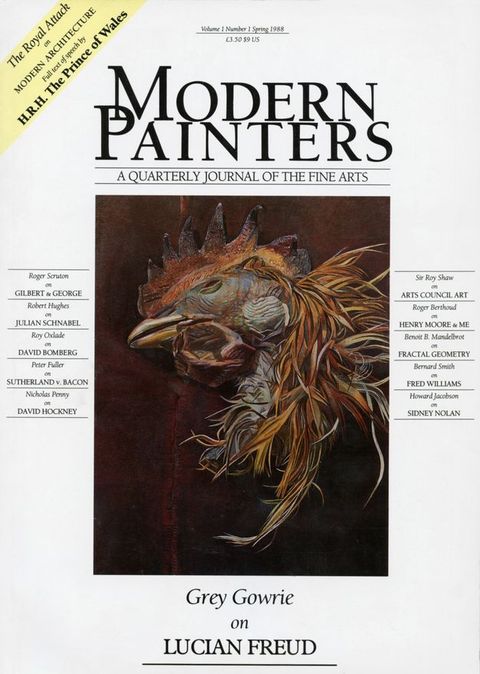
Contrary to the popular saying, certain judgements can be made on the basis of the cover of the first issue of Modern Painters. This was a journal that sought to innovate in the sphere of art criticism, not design. While the cover features a reproduction of a Lucian Freud painting discussed in Grey Gowrie’s article, the image is flanked by two columns listing the journal’s contents. The journal’s masthead looms above, with “Modern Painters” spelled out in large, black serif capital letters. The only design flourish is the interlinking of the title’s M and P. The cover’s prioritising of text over image fittingly introduces the ensuing pages, which are sparsely illustrated—mostly in black and white—and packed with text, often to the detriment of readability and overall design. In light of these design choices (or, perhaps more fittingly, non-choices), it makes sense that Fuller insisted that Modern Painters was a journal rather than a magazine, even though it was far more likely to be found at a WH Smith than in a university library.
Further judgements can be gleaned from the decision to highlight a contribution by Charles, then the Prince of Wales, with a yellow banner in the top left corner. Fuller had obtained permission to reprint his speech at Mansion House in 1984 in which he attacked modern architecture, accusing it of “aesthetic idleness”.3 Fuller’s editorial “welcome[d] the Prince’s words”, albeit four years later (figs. 2a and 2b).4 The first issue of Modern Painters extended his accusation to contemporary art. From Roger Scruton’s scathing attack on Gilbert & George to Roy Shaw’s whistleblower account of the excesses of the Arts Council, Fuller immediately set Modern Painters apart from other art publications, which largely cheered on the new developments in art. A prime target in this regard was Artscribe. In the introduction to a mock interview conducted with Matthew Collings by Matthew Collings, Fuller denigrated the journal’s pursuit of “contemporary, internationalist” British art represented by the Turner Prize, the Saatchi Collection, and Art and Language.5 Modern Painters, he countered, “would like to see [those things] transformed, or eradicated”.6
3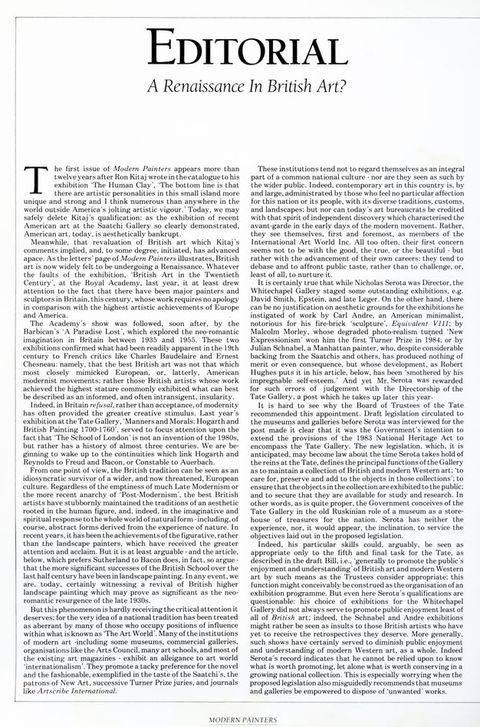
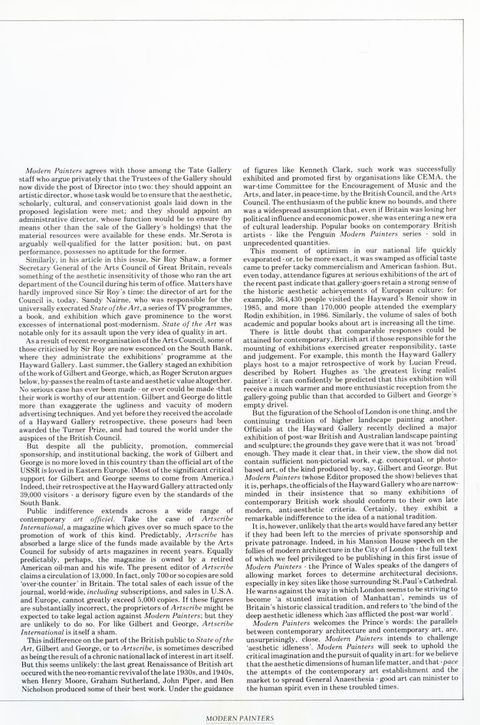
Fuller’s strong words beg the question: what did he hope would replace “contemporary, internationalist” art if it were to be transformed, or indeed eradicated? The attempt to answer this question with and through Modern Painters is what sets Fuller’s efforts apart from other dissenting voices at the time (and after). The journal attests to Fuller’s positive programme for British art as much as it does to his criticisms of it. Again, his editorial is instructive. It posited a humanist vision for British art that was at once invested in aesthetic experience and resistant to both modernism and modernity. This vision allowed Fuller to contrast British art favourably with American art, which he claimed was “aesthetically bankrupt”.7 Instead of nurturing artists who derived their inspiration from the human figure and the experience of nature—key tenets of Fuller’s British art—America had produced Julian Schnabel.
7To be sure, Fuller’s vision for British art drew on old ideas borrowed from the category’s past. This does not mean, however, that Modern Painters was not oriented toward the present. Fuller’s editorial posited a renaissance for British art, one that would reprise both a traditional concept of art and the idea of a national tradition. Taken together, the intervention attempted by Modern Painters can be felt with full force. While Fuller’s aesthetic advocacy jarred with postmodernism’s anti-aesthetics, his affirmation of a national tradition was entirely at odds with British art’s increasingly international ambitions. His Art Monthly article “Against Internationalism” put an even finer pin on the latter point. “One of the problems with today’s generation of artists”, he polemicised, “is that they see themselves as belonging to The International Art World Inc. before they conceive of themselves as contributing to a uniquely British tradition”.8 By conserving a continuity with that tradition, Fuller hoped that Modern Painters could reroute British art back to itself.
8It is important to note that the conservatism motivating Modern Painters and its vision of British art was conservative with a small c—Fuller was a vocal critic of Margaret Thatcher’s government. This position certainly did not reconcile him with the Left he had disavowed in the early 1980s, however. As he would later put it, “If there is one thing I find as distasteful as Thatcherism, it is anti-Thatcherism”.9 While Fuller’s comment was principally directed at the anti-Thatcherism of the Left, his “distaste” for this rhetoric also distinguished Modern Painters from the right-wing anti-Thatcherism of The Salisbury Review. Edited by Scruton, The Salisbury Review launched in 1982 in the heat of Thatcher’s first government.10 In contrast, Modern Painters emerged in Thatcherism’s dying embers. As much as the journal was conditioned by the politics of 1980s Britain, it also looked ahead to the 1990s.
9The vision for British art put forward in the first issue of Modern Painters never came to pass. The redefinition of British art would instead be taken up by the generation Fuller had admonished in Art Monthly. In July 1988, shortly after the journal went to print, Damien Hirst’s curatorial effort Freeze opened in London’s Docklands. While the Young British Artists were identified by their Britishness, their engagement with any sense of a national tradition was ironic, to say the least. Moreover, their assent was inseparable from the effort to internationalise both British art and art in Britain by organisations such as Tate and the Arts Council. The combination of this institutionalised internationalism with the conceptual, market-oriented art of the YBAs was as close to a rebuttal of Modern Painters as its detractors could have hoped for. But Fuller did not live to see this rebuttal. He died in a motoring accident in April 1990, just two years after his journal had launched. Modern Painters continued without Fuller, but the journal lacked his distinct point of view. While Brian Sewell’s 1990s criticism picked up some of the dropped threads of Fuller’s critique of contemporary British art, unlike Fuller, he made his critique without a fully fleshed out alternative in mind.11
11If the gambit of Modern Painters was to intervene in British art, it is safe to say that intervention failed. How might a history of contemporary British art make sense of that failure? Is there space in our understanding of that history for the paths untravelled as well as those that were taken? These are the key question motivating this One Object feature, which seeks to make room for Modern Painters by treating it as continuous with, rather than as a deviation from, the recent history of British art. To that end, each of this issue’s five contributors have plugged the journal’s first issue back into the context, debates, and art world of late 1980s Britain. Tempting though it may be to discount Modern Painters as an entirely chauvinistic proposition that is antithetical to our contemporary understanding of British art, these contributions reveal that a history of contemporary British art without Modern Painters would present an incomplete picture. Indeed, given the occasional (and surprising) similarities between how British art was discussed in Modern Painters and how the category has been taken up in this journal, the assumptions about where the continuities and discontinuities lie between these two moments cannot be taken for granted.12
12The view of British art in the late 1980s projected by the first issue of Modern Painters was, to repeat Fuller’s words, “depressing”. The urgency of his critical intervention depended on this characterisation. Rather than leave this accusation hanging, Karen Di Franco’s contribution places Modern Painters in dialogue with other journals from the period. Plotting Modern Painters alongside journals such as ZG and Block, Di Franco tracks the longer history of Fuller’s engagement with art publishing in the United Kingdom. In particular, she raises the stakes of the journal’s stance on figuration by juxtaposing it with the critique of representation so crucial to feminist journals during this period. While Di Franco’s contribution contextualises Modern Painters by looking beyond the journal to the wider art publishing landscape, Stephen Moonie’s close reading of the letters pages reveals some of that context already accounted for in the journal itself. With notes of dissent printed alongside praise and approval, these pages suggest that Modern Painters played host to a wider conversation about British art and art criticism, complicating—as Moonie has it—“our sense of the journal as a monolithic project neatly aligned with Fuller himself”.
While invoking an earlier moment in the history of painting, Modern Painters was also engaged with debates about the medium that were particular to the 1980s. Declared dead (again) at the beginning of the decade, the medium had supposedly been revivified by neo-expressionism. Fuller had about as much time for arguments about painting’s demise as he did for neo-expressionism. Yet, as Kevin Lotery’s contribution reveals, the returns to which both Modern Painters and neo-expressionism both appealed had a shared regressive character. Where Lotery explores the position of contemporary painting in Modern Painters through a reading of Robert Hughes’s article on Schnabel, James Baggott-Brown explores the contemporary reception of Graham Sutherland and Francis Bacon in Fuller’s feature article. To explain why Fuller’s preference was for Sutherland and not Bacon because of the former’s grasp of “human potentiality”, Baggott-Brown examines Fuller’s intellectual passage through the 1970s and into the 1980s. If that passage is commonly understood as Fuller’s turn from left to right, Moran Sheleg’s contribution highlights that the political terrain under which these terms were claimed was by no means certain in 1980s Britain. Locating what she called the “Ruskin effect” across the political spectrum, Sheleg’s piece opens up what she calls a “common ground” between Modern Painters and the art, artists, and critics whom the journal held in contempt.
This is the first One Object feature to focus on a journal in British Art Studies. As such, the feature hopes to demonstrate that the possibilities presented by objectifying an issue of a journal or magazine are equal to those yielded by a single artwork. Swapping close viewing for close reading, many of the contributors have focused as much on Fuller as they have the first issue of Modern Painters. Fuller was not only the chief author of this text, but the journal is inseparable from his vision for British art. In returning to Fuller’s first editorial articulation of that vision, the following contributions not only resurface the moment of the inaugural issue of Modern Painters, but they also allow us to read the journal through a contemporary lens. Thus, when Fuller wrote, “we have to find the courage to admit the mistakes of the last thirty years”, readers of this feature should be able to grasp both the promise and the pathos of his statement.13 Modern Painters did not set in motion its planned cultural reckoning. Instead of intervening in contemporary British art, it became part of it. With the first issue of Modern Painters itself now almost thirty years old, it is the task of journals such as British Art Studies to begin writing its history.
13Contribution by
-
Stephen MoonieSenior Lecturer in Art History, Department of Fine ArtNewcastle University
“It’s Your Letters!”: The First Issue of Modern Painters
Letters pages may appear inconsequential, with little to offer beyond period charm.14 However there exists a scholarship on letter-writing which explores its aspects from a variety of angles.15 This article considers the first issue of Modern Painters.16 Its lively section of “Letters to the Editor” broached the current state of art and criticism that had motivated Peter Fuller’s project to reorient a modern tradition he felt had gone awry. But the different voices contained within those pages expand and complicate our sense of the journal as a monolithic project neatly aligned with Fuller himself. This polyvocality offers a glimpse into the tensions within this attempt to restore a tradition of painting.
14The letters pages have a proleptic quality (figs. 3a–3c). Fuller had written to various artistic luminaries, providing them with abstracts for the first issue.17 Despite this preview, the letters anticipated what correspondents thought, or hoped, the journal might become. The choice of artists was broadly indicative of Fuller’s aims. Most worked in a recognisable tradition of painting, whether abstract or figurative. But they comprised a heterogeneous group, stylistically and generationally. This is reflected in the range of views expressed.
17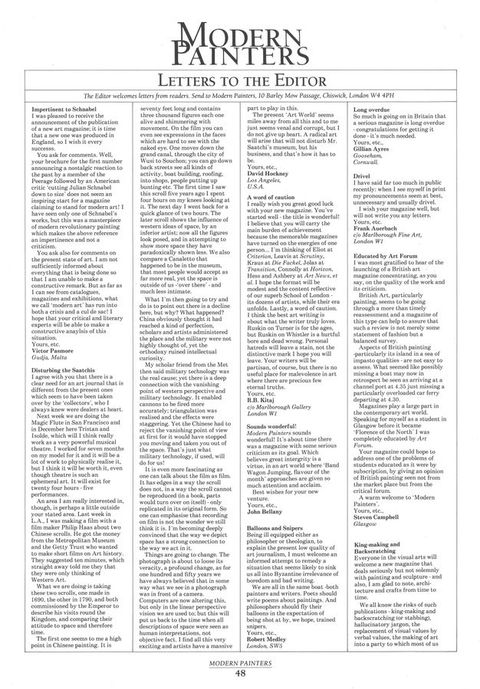

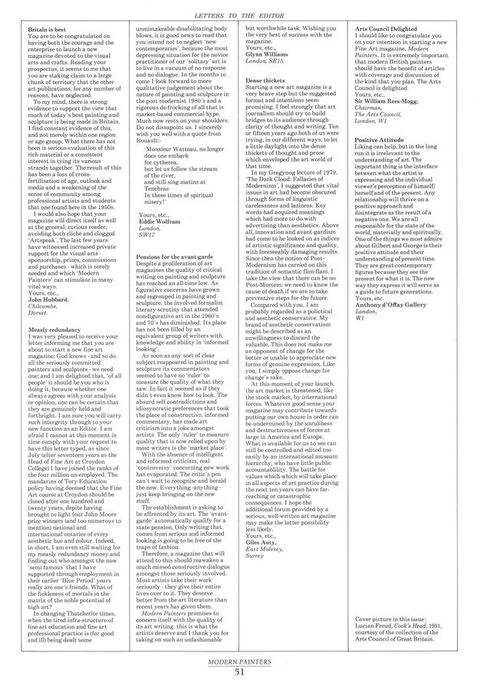
If we consider some of the contributors by age group, we get a sense of this variety. Victor Pasmore (1908–98), Patrick Heron (1920–99), and Leon Kossoff (1926–2019) were elder statesmen in 1988, albeit each representing different strands of modern painting. A group of artists in their fifties also responded to Fuller’s call, constituting an equally varied group: Frank Auerbach (1931–2024), Gillian Ayres (1930–2018), Patrick Caulfield (1936–2005), Howard Hodgkin (1932–2017), and R. B. Kitaj (1932–2007). John Bellany (1942–2013), Maggie Hambling (b.1945), and David Hockney (b.1937) were in their forties. Steven Campbell (1953–2007), then in his mid-thirties, was the relative youngster. Those ages reflect a conviction that artistic recognition ought to be earned and should not be bestowed too quickly. The post-war trend towards an accelerated recognition of younger artists, in conjunction with an increasingly rapid turnaround of artistic styles was a trend deplored by critics such as Fuller. Campbell appears as an anomaly in this respect. He came to prominence at a relatively young age during the “return to painting” in the 1980s, in his case as a member of the “New Glasgow Boys”. He moved to New York but had returned to Scotland by the time of the launch of Modern Painters. On the one hand, this return to painting seems in tune with Fuller’s vision, but Campbell’s large allegorical paintings, which refer to literary figures and theorists such as Michel Foucault, exemplify an eclectic postmodernism that Fuller otherwise decried.18 Campbell’s painting Bonjour M. Foucault, which is no longer extant, was commissioned as a 6 × 3 m outdoor hoarding to mark the opening of Tate Liverpool (fig. 4).19 The cluttered landscape is populated by figures such as a boxing kangaroo and a blindfolded cricket player who lies prostrate at the feet of the eponymous figure. This figure, who does not resemble Foucault, shakes hands with a figure made of glass that is shattering into pieces.20 Despite the non-likeness, Campbell’s A Life in Letters: Idealised Portrait of the Wig’ed Foucault (1986) was used as the cover illustration for the Penguin edition of The Foucault Reader in 1991.
18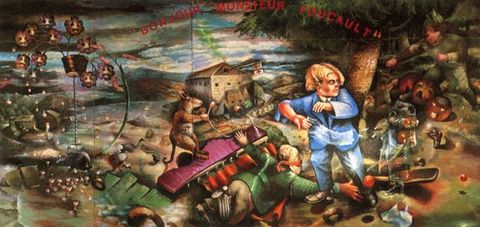
The first letter is from Pasmore. He is not an artist one would readily associate with Fuller either; his abstract paintings are closer in spirit to an international modernism rather than the “British” variant envisaged by Fuller (Pasmore was living in Malta at the time). Further, the Bauhaus-inspired methods of teaching that Pasmore pioneered at Newcastle University were at odds with Fuller’s vision of art school pedagogy. Nonetheless, Pasmore noted that “what we call ‘modern art’ has run into both a crisis and a cul de sac”!21 The reference to Schnabel as “modern”, not “postmodern”, indicates the contested nature of those terms and, more specifically, that Pasmore remained committed to an idea of “modern” painting. In this sense, he might appear in sync with Fuller. But Pasmore was unimpressed by the preview promising that Robert Hughes would be “cutting Julian Schnabel down to size”. He contended that the one Schnabel painting he had seen was, in his view, “a masterpiece of modern revolutionary painting which makes the above reference an impertinence rather than a criticism”. Pasmore’s upbraiding of the Australian Hughes was compounded by his incorrect reference to him as an “American”, perhaps on account of his articles for Time.
21Patrick Heron shared Fuller’s commitment to the medium of painting (and, elsewhere, his antagonism to the art of the United States).22 Heron declared that “painting is (and always has been) of more immediate and more enduring, interest than any other form of visual art”.23 As for the modern, this was for him a “favoured adjective … It signifies the immediately relevant, the currently most urgent”. He added that this is not a question of contemporary versus historical, for the moment of aesthetic electrification one experiences from Titian is no different in the end from viewing Henri Matisse (Heron’s modernist exemplar).24 “Only as the old feels new are you breaking through to its reality”, he writes, before signing off with a mischievous flourish: “good luck to Modern Painters—though I mayn’t like a word that’s published in it”!
22There is little mention of such aesthetic experience elsewhere in the letters pages. This is surprising given that it could be understood as a core part of the journal’s mission. Take the taciturn Frank Auerbach, who declared a refusal to write “drivel”.25 This stubborn commitment reinforced a distinction between painting and its critical discourse, turning Marcel Duchamp’s insult bête comme un peintre into a virtue. David Hockney’s lengthy contribution showed him less interested in the new publication and more enthused about Chinese scrolls in relation to his own interests in photography and perspective. Other correspondents, however, were more concerned with a perceived problem in the language of criticism, in tandem with the broader climate of arts funding. William Rees-Mogg, chair of the Arts Council of Great Britain between 1983 and 1989, offered his brief congratulations. Nonetheless, as chair he oversaw the removal of funding from half of the organisations under the Arts Council’s remit. Decades later, his son Jacob, a member of Alexander Boris de Pfeffel Johnson’s cabinet, hinted that Arts Council England could be abolished altogether.26 Modern Painters was born during the era of Thatcherism, its launch coinciding with the Black Friday crash in 1987. Fuller, however, like other conservatives, lamented its effects. Eddie Wolfram wrote in to announce his redundancy after the closing of Fine Art at Croydon College, declaring himself a victim of “the mandarins of Tory Education policy”.27 He signed off with a quote from Georges Rouault, suggesting that we “sing matins at Tenebrae / In these times of spiritual misery!” This call for consolation strikes a chord with Fuller’s later writings.
25Other correspondents wrote more directly about art criticism. Kitaj, for instance, struck a hopeful note (for criticism rather than impertinence). The noted bibliophile flattered Fuller by invoking the great editors of old: “Eliot at Criterion, Leavis at Scrutiny, Kraus at die Fackel, Jolas at Transition, Connolly at Horizon, Hess and Ashbury at Art News, et al”.28 He struck a cautionary note, however, on the danger of criticism motivated by hatred rather than love: “Ruskin on Turner is for the ages. Ruskin on Whistler is a hurtful bore and dead wrong”. In issue number 2, a correspondent, David Allen, wrote a letter to ask why Modern Painters did not heed Kitaj’s advice.29
28In 1994 Kitaj was enraged by the critical response to his Tate retrospective. Brian Sewell and Andrew Graham-Dixon had been especially acerbic. Sewell described Kitaj as “a vain painter puffed with amour-propre, unworthy of a footnote in the history of figurative art”, while Graham-Dixon asked rhetorically, “The Wandering Jew? The T. S. Eliot of painting? Kitaj turns out, instead, to be the Wizard of Oz: a small man with a megaphone on his lips”.30 Kitaj angrily attributed this to anti-Semitism. He blamed the critical fallout for the aneurysm that killed his second wife, Sandra. His painting The Killer-Critic Assassinated by His Widower, Even repurposed Edouard Manet’s The Execution of Emperor Maximilian (1868–69) as a form of pictorial revenge (fig. 5). Painting in a style that marries the loose, expressionist quality of his late work with the references and annotations characteristic of his earlier painting, Kitaj (who in the painting resembles Manet himself) takes aim as the second rifleman at the hydra-headed figure of the critic. In retrospect, this fallout from the Tate retrospective sharpens the pertinence of Kitaj’s earlier warning, reminding us of the damage criticism can wreak if “motivated by hatred rather than love”.
30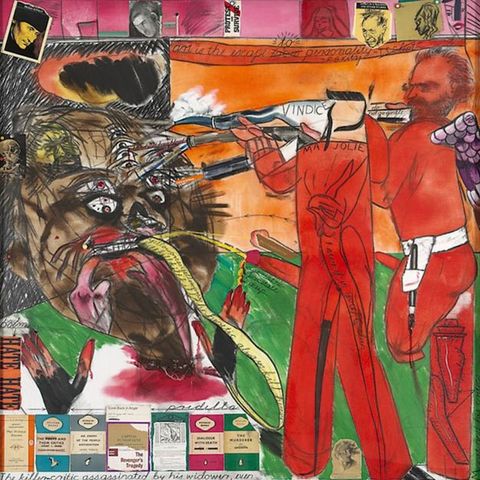
The sculptor Glynn Williams, whose work was praised elsewhere by Fuller, voiced a familiar concern on the decline of art writing and critical evaluation.31 He felt this had deteriorated since the formalist writing of the 1960s and 1970s. The reappearance of figurative content in the 1980s had, he argued, left commentators “with no ‘ruler’ to measure the quality of what they saw. In fact, it seemed as if they didn’t even know how to look”.32 Art criticism, he claimed, had become a joke among artists and hence Modern Painters’ aim to address this situation was to be commended.
31Williams also noted a broader conviction in the 1980s that the marketplace threatened to replace the judgement of the critic. Giles Auty, a painter who would later take on the role of art critic for The Spectator, struck a similar vein. He wrote of his recent project to clear the fog of art jargon, which, he argued, was riddled with “linguistic carelessness and laziness. Key words had acquired meanings that had more to do with advertising than aesthetics”.33 Auty claimed Fuller as an ally in this quest, although he qualified this by adding, “compared with you, I am probably regarded as a political and aesthetic conservative”. Was Auty insinuating that Fuller was still shaped by earlier Marxist commitments? Or that Fuller’s support for the likes of Auerbach or David Bomberg was, aesthetically, a stretch too far? Such distinctions between conservatives appear somewhat arcane.
33Edward Lucie-Smith also complained of “art speak”. Art magazines, he argued, should be written in a language that “everyone speaks, not a bastard dialect full of alien constructions and unnecessary borrowings from German”.34 He advised that Modern Painters chart a path between the “appallingly costive and pretentious (the Art-and-Language group) [sic] to the flaccid populist writing, occasionally spiced with malice, of the heavy Sundays”. Robert Medley made a similar complaint regarding “the present low quality of art journalism”, which was at risk of sinking into “Byzantine irrelevance”. He proposed a division of labour whereby “poets should write poems about paintings. And philosophers should fly their balloons in the expectation of being shot at by, we hope, trained snipers”.35 (We can assume that, like Auerbach, he believed that painters should keep quiet and paint.)
34There is nothing particularly new about lamentations on the quality of art criticism, but nonetheless these remarks pick up on the nature of Fuller’s broader project. Julian Stallabrass, in a 1994 essay, referred to the “peculiar mixture of populism and snobbery” characteristic of conservative writers on art.36 Fuller’s project positioned himself on the side of the “common man” perplexed by modern and contemporary art, but he nevertheless invited Prince Charles to write on architecture in the first issue. Fuller’s vivid prose exemplified a pragmatism thought to be characteristically British (which usually means English). However, the political convulsions of the United Kingdom in the last ten years have done significant damage to any claim to pragmatism. Indeed, we see intimations of a looming nationalist resurgence in the letters of Lucie-Smith and Auty. While Auty commended the launch of Modern Painters, he hinted darkly, not to say conspiratorially, at the looming threat of the market and “the unruliness and destructiveness of forces at large in America and Europe”.37 This figurative storm threatened the “common sense” of an England of cricket fields and warm beer.38
36Among these various topics there was an unlikely common thread. In issue 2, Colin Failes remarked that, while he enjoyed the first issue, he was “amazed to see the names Gilbert and George endlessly, and in almost every article”.39 The pair, excoriated by Roger Scruton in the first issue, signified everything that was wrong with contemporary art in the conservative imagination. Queer, scatological, and humorous, Gilbert & George seemed to stand in opposition to the spiritual yearnings of Fuller’s project, which he identified with a pastoral tradition extending into the modern painting of Ivon Hitchens or John Piper. The pair were also supporters of Margaret Thatcher.
39But they were an object of scorn not only for the “young fogeys” at Modern Painters; they were represented as the recurring characters Egbert and Bill, “performance artists”, in the BBC comedy series The All New Alexei Sayle Show (1994–95). Each sketch was accompanied by Erik Satie’s Gymnopédie No. 1. The pair literalised the notion of “living sculptures”: in every scene, they stood stock-still in their characteristic suits, staring vacantly into space. They spoke rarely and then in vacant monotones. They changed posture with each cut of the camera. This was used to comic effect in various ways, whether the pair were “dancing” at home to Lipps Inc.‘s “Funkytown”, playing tennis (when the soundtrack changed from Satie to the BBC’s Wimbledon theme), or visiting the beach for a day out with a pair of frolicking female friends. Unlike their real-life counterparts, they were utterly humourless save for the occasional idiot savant pronouncements. When a Samaritan comes to their door, asking cheerfully, “Are you willing to let the Lord Jesus Christ into your life?” the pair reply, deadpan, “Come in, Mr Christ.” The Samaritan is driven away after Egbert drifts off into a lengthy reverie, visions of Gilbert & George-style imagery appearing in his mind’s eye. In another sketch, the pair invite two guests round for dinner, played by James Nesbitt and Arabella Weir. The duo serves alphabet pasta spelling the words “fart” and “we are going to kill you”. These provocations might remind us of the Young British Artists (YBAs), but they intimate other tongue-in-cheek instances of text-based art. The guests are reminded solemnly that dinner, like art, should shock (for dessert, the pair squirt whipped cream directly into their guests’ faces).
Sayle’s representation of the pair may be viewed in a similar spirit as Fuller or Scruton, albeit from an opposite political standpoint. Raised by communist parents in Liverpool, the young Alexei was mocked by classmates for his exotic name. Although he reacted against his parents’ idiosyncrasies (such as holidays in Czechoslovakia), he has maintained a left-wing stance. Sayle’s satire of Egbert and Bill’s diffident pretensions has a more pronounced class angle. This is not wholly a consequence of his political views but was also shaped by his experiences as an art student in London during the 1970s. Scruton, for his part, rehearsed a familiar conservative argument that the pair’s aesthetic and moral “emptiness” was a product of the moral turpitude of the sixties. A more interesting aspect to his essay is the claim that their demotic appeal veiled a new contemporary patronage that sustained them.40
40Despite this shared antagonism to Gilbert & George, it is not my claim that they evince a horseshoe theory of politics, where left and right are equally misguided; but there is a curious dovetailing nonetheless, which speaks to the place of contemporary art in the public imagination. The two critiques are marked by fascination (if I may be so bold as to argue for a TV comedy sketch as critique). It is as if, for Modern Painters especially, the journal needed to define itself agonistically. What it was for, however, appears to be less clear-cut. Gilbert & George may have signified the “enemy”, but the polyvocality of the letters pages attests to the status of modern painting remaining contested.
Contribution by
-
Karen Di FrancoSenior Lecturer in Curating & CollectionsChelsea College of Arts, University of the Arts London
Peter Fuller: In Search of the Mainstream
In his editorial to the first issue of Modern Painters, Peter Fuller, the magazine’s founding editor, referred to a group of institutions, organisations, and people that Modern Painters was resolutely against (see figs. 2a and 2b). Alongside the Arts Council, patrons of the “New Art”, and the Turner Prize, the magazine Artscribe International was picked out as a specific object worthy of Fuller’s ire. Accused of “promoting a tacky preference for the novel and fashionable” instead of a “revival of British higher landscape painting”, Artscribe International was, according to Fuller, a prime contributor to a disregard by the arts sector of a “common national culture” and a lack of both care and acknowledgement of either tradition or the spirit of discovery.41 This wasn’t the first time Fuller had targeted magazines in his art criticism. In 1976, when the Victoria and Albert Museum staged the exhibition The Art Press: Two Centuries of Art Magazines and Studio International produced an accompanying special issue on art magazines, he had contributed a review in New Society and a longer article in Studio International that offered both his viewpoint on the history and current state of affairs in art publishing and an elaboration of his vision for the role of magazines and the status of British art.42
41To an extent, Fuller’s opinions on these projects reappear in 1988, but perhaps his earlier criticism has less to do with the chauvinistic aims associated with Modern Painters, being instead desirous more of a space free from “cynical commercial motives”.43 In the 1970s, he was motivated by a Marxist politics that sought to democratise the production and reception of art by moving them away from the malign influence of the monied class; endorsing the then arts minister Hugh Jenkins’s argument that “art should be entirely freed from the market so that historically significant works would become available to all”.44 Fuller’s views on the role of the magazine in the 1970s appear to be nothing less than radical. Yet, as he moved through this decade into the 1980s, his position on what art was constrained his ability to open out the “space for criticism” that he felt was absent from the cultural mainstream in this period. Fuller’s writing as a critic lived in magazines, but his commitment to accommodate only positions and practices that reflected his own interests resulted in a marginalisation rather than a mainstreaming of such ideas. Mirroring the trajectory of debate around the economics and status of art in the general population, Fuller’s eventual contribution to creating the space he felt to be necessary was Modern Painters.
43The two articles by Fuller from 1976 argue that the effects of commercialisation on the art world and art publishing damaged the mainstream understanding of British art history (fig. 6). Positioning criticism as an active arbiter between artworks and the public, he argued that the key questions on the relationship between “men, nature, masterpieces, and the tradition” were unresolved because of the failures of art criticism and the magazines that commissioned it.45 These points, highlighted in the first article and further developed in the latter, were understood to be exacerbated by the pluralism of the art world, which had been corrupted and contaminated by its attachment to market forces. The ensuing “crisis in art”, positioned by Fuller alongside John Tagg and Richard Cork, in part as a response to these and other issues, produced an intensive period of art criticism. In building his case for a “rigorous critical” magazine in response, Fuller expanded the range of magazines he wrote for, capitalising on a rapidly developing context that he himself was involved in manufacturing. While this opportunity offered him the chance to shape and affect the discourse, his criticism often lacked accuracy or indeed adequate research into the subject at hand.46
45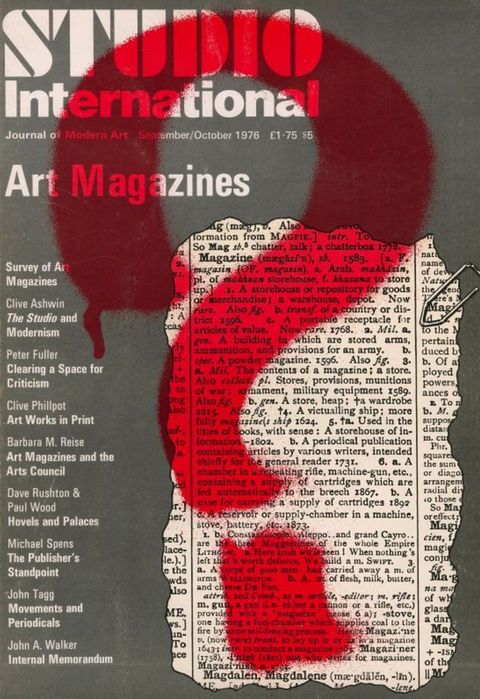
Both Fuller’s articles and Studio International’s issue on art magazines raise valuable questions in regard to how critics and magazine editors saw their own influence and importance in representing and shaping artistic practice and discourse. Studio International had dominated the sector under Peter Townsend’s editorship by showcasing American and European conceptualism in the 1960s. By the mid-seventies it saw reason to address its position in defence of what were, in the new editor Richard Cork’s statement in the September–October 1976 edition, “absurdly institutional expectations” whereby the magazine was assumed to fulfil a role as an “official national channel”.47 Given that it had a large institutional subscriber base and had recently been acquired by the millionaire architect Michael Spens, who in 1975 had fired Townsend and hired Cork, this defence was pertinent to the trajectory of the magazine under Cork. As the decade progressed, his steer is now seen to have contributed to the conditions for the establishment of both Art Monthly and Artscribe, the first aimed at promoting “British Art in its national context” and the latter a result of Cork’s lack of interest in painting and sculpture.48 Regardless of the realities of such influence, at the time of the magazine’s special issue, Cork and Fuller were united in their concern around commercial influence on either art or art criticism, but pursuing separate agendas, with Fuller focusing more on the use of government funding for Tate as a “middle-class obsessional game” of an acquisitions policy to which he was violently opposed.49 Their established positions—one a commissioning editor, the other a writer for hire—along with their privilege of both gender and ethnicity, meant that, for Fuller, specific art forms, interest areas, and groups of people could be dismissed or ignored in his writing, despite the proliferation and platforming of feminist, Black, and Asian art in institutions during this period.50
47In a display of apparent editorial transparency, the Studio International “Art Magazines” issue attempted to survey and highlight questions about the industry, such as how art magazines were funded, who owned them, what audiences they were aimed at, and whether they prioritised criticism or information. The sixty-eight responses received were published without differentiating between commercial titles and artist produced periodicals.51 Artforum, for example, declared an operating budget of $45,000 with an issue run of 20,000, while Artscribe noted that, with a print run of 2,000 and a budget of £200 per issue, its editor’s work was unpaid and it had no employees. Others, such as Artifact, a new UK imprint, had no working budget and a first issue run of 5,000. It is also worth noting that there were only nine (eight, not counting Studio International itself) UK-based titles, of which five had produced only a single issue at that point (Artifact, Extremes, One) or were artist-edited (One, Audio-Arts, Control Magazine). What emerges from the broader survey, however, is a frequently stated editorial indifference to both the art market and advertisers, and a conflicting sense of how much magazines could influence the scenes they responded to.52 Instead of exposing undue external influence over editorial freedoms from owners, the survey described a wide range of shoestring operations that frequently depended on unpaid writing submissions and reader subscriptions.
51Several questions in the survey went unacknowledged and seemingly unnoticed by Cork and Fuller: the economic barriers placed on potential contributors by the lack of payment for their contributions; the role of experimental writing within artistic practice that shaped several of the publications within the Studio International survey; the expanding field of artists’ publications as distinctive and separate from commercial publications; and the contribution of female practices within art and publishing both broadly and specifically. These omissions indicate how Fuller’s and Cork’s ideas deviated from the Marxist materialist lens that had previously focused their ideas: neither fair pay nor equality ever entered the debate from their perspectives on art criticism. For Cork, critical discourse continued to be abstracted as “social purpose” as art rather than as having the potential to create fairer conditions, while Fuller retreated further from the left towards what has been described as “rescuing an emancipatory view of the aesthetic” rather than shifting the burdens of capitalism.53
53Continuing his series of themed issues, Cork commissioned a special issue of Studio International on women’s art in 1977, a belated gesture that Art & Artists had already made with its issue on women’s art in 1973.54 In his editorial note he bemoaned the lack of a British magazine “wholly devoted to women’s art, feminist or otherwise”, seemingly unaware of the many feminist and lesbian networks (such as the Women’s Free Arts Alliance), newsletters, single and special issue artist publications, and perhaps more significantly Spare Rib, which included writing specifically on women’s art.55 While his editorial struggled with the age-old male art dialectic, the issue itself revealed autonomous scenes of artists, curators, and writers fully engaged with instigating and reproducing inclusive spaces and publications to house their work. A glance across the contributors to the 1973 and 1977 issues confirms the presence of Lucy R. Lippard, Yve Lomax, Carla Liss, Susan Hiller, Lynne Tillman, Rosetta Brooks, Sarah Kent, Mary Kelly, who were either involved with, or would in the early 1980s join, publications such as BLOCK, Wallpaper, Unmuzzled Ox, Heresies, Profile, Top Stories, ZG, REALife, and Wedge.56 These titles, which provided alternative spaces for experimental and critical writing, were joined by Chrysalis in the United States and Feminist Art News (FAN) and MAKE magazine in the United Kingdom, which focused exclusively on female and feminist practices.
54Indeed, the context specificity of the special issue, aimed at being a locus for criticism, became a catalyst for stratification as the 1980s began. Instead, and perhaps as Fuller had predicted in his many critiques of postmodernism, arts publications were more than ever commissioned and read by those involved in their production. As diversified communities who were not represented by such titles grew and were activated to self-publish, the perceived traditional mainstream audience for magazines such as Studio International decreased.57 In the context of art publishing, diversity was disproportionally understood by critics as a symptom of the commercial imperative of the market, alongside the ongoing cultural devolution encouraged by the policies of the Arts Council of Great Britain. For writers such as Fuller, diversification signalled a retreat from art capable of social transformation towards art that only mimicked a once radical position. Previously united with Cork in their viewpoints on this subject, Tagg and Fuller parted ways with him in a backstabbing article published in Art Monthly.58 Before long, the duo also split as Fuller shifted his writing further towards a conservatism that framed the aforementioned “traditional” mainstream as one united by a collective understanding of art’s transcendent capabilities within a biological interpretation of figuration, to describe what he saw as “enduring representations” in art, through images relating to birth, reproduction, love, and death. He extended this view into a dismissal of feminism, declaring that there was no “such a thing”: “The feminist art movement is nonsense, complete nonsense, from start to finish”.59 Figuration for him was constructed around his ideas of the feminine rather than the feminist, and therefore a connection to a certain “essentialist biocriticism” can be understood as entirely aesthetic, but this collision provided a window onto a broader set of critical implications facing the reception of feminist practices at the time, when it was reframed in institutional exhibitions such as the Hayward Annual '78 (1978), Women’s Images of Men, About Time (both 1980), and Issue (1981).60 The space afforded to female practices by institutions sat in opposition to Fuller’s formulation of what constituted art, but when he was questioned by readers in response to his provocative claims and held to account about the dominance of men as subjects and as contributors to the first issue of Modern Painters, he provided no editorial response.61
57At the end of the 1970s, converging on several overlapping and interwoven discourses focused on critical postmodernism and Marxism, social practice, and criticism itself, Fuller’s writing proceeded to reject previous allies and to further contract the critical space in which he had positioned himself. He described Terry Eagleton, Griselda Pollock, and Victor Burgin as “decadent stylists”, and “social functionalism” (through his extended quarrel with Cork) as “infecting the fringes of art institutions”. His own interventions into psychoanalysis led him to voice again a “growing dissatisfaction with the aridity of much of the current left debate about the visual arts”.62
62Rosetta Brooks, who was involved with the scene around St. Martin’s School of Art that included artists such as John Stezaker, an artist frequently dismissed in articles by Fuller, asserted in her editorial to the first issue of ZG in 1980 that the lack of an artistic mainstream had created “false barriers between different worlds of cultural experience and a return to the safety of traditional ideas”.63 The diminution of the mainstream was, in her view, tethered to the loss of more avant-garde practices, and her response to this was ZG, a magazine that attempted to explore a cultural mainstream without disciplinary boundaries, connecting to many artists, writers, critics, and musicians who were all immersed in technological landscapes that overlapped and mutated ideas and affect. Brooks’s project, and those of the artists she worked with—Yve Lomax, Cindy Sherman, and Sherrie Levine—were a very specific enquiry into the effects of media, consumerism, and reproduction on the female body (fig. 7). Similarly, artists affiliated to the British magazine BLOCK (fig. 8), produced in the Art History Department of Middlesex Polytechnic, and the US-based Wedge (fig. 9) harnessed the special issue format by collaborating on an edition that extended the exhibition Difference: On Representation and Sexuality (1984–85) into print circulation. Focused on the proposition of sexuality as socially reproductive, the exhibition’s “thesis”, as described by the curator Kate Linker, was located in Lacanian psychoanalytic theory.64 These magazines were attempting, like ZG, to offer “a wedge of critical discourse to open a wider and more challenging debate”, as described by Wedge’s co-editor Brian Wallis.65 John Bird, one of the editors of BLOCK, later recalled: “The models we looked to were the underground press, Red Letters, Wedge and Artery … but BLOCK was the first properly institutionally-based journal that was combining that look with rethinking notions of traditional discipline … exploring interdisciplinarity in the field of culture”.66
63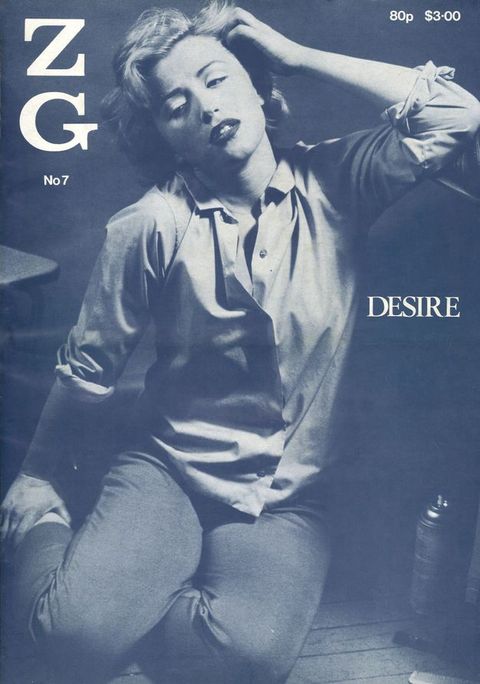
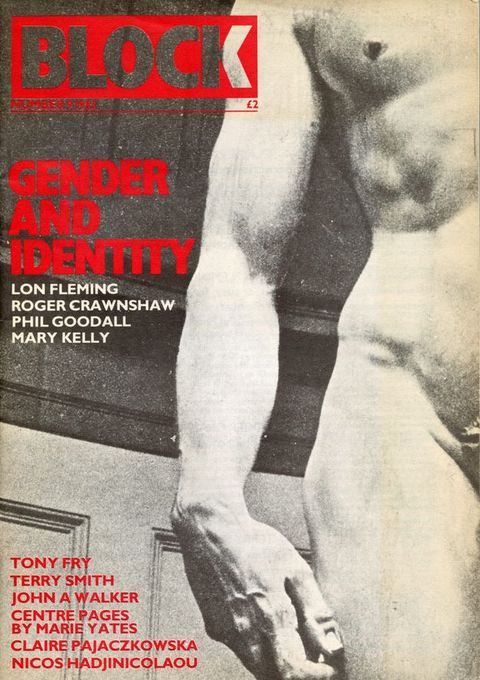
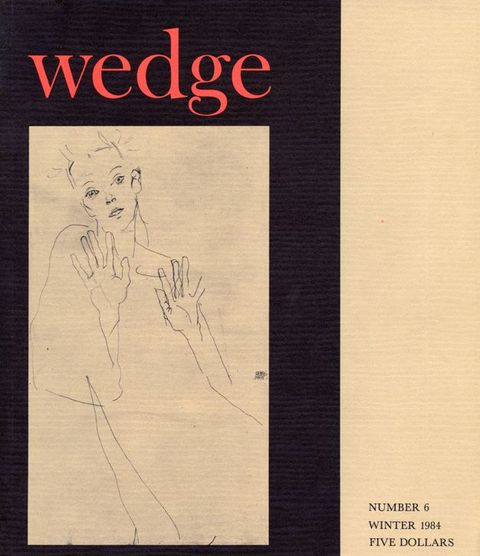
With such dramatic changes in the UK art publishing landscape taking place in a period when much broadsheet space dedicated to the arts was taken up by writers espousing views not dissimilar to his own, Fuller’s own break with “Althusserian Marxism”, as he described it, was a final response to the collapse of disciplinary boundaries within contemporary arts practice. Abandoning his previously held leftist political position, he wholeheartedly took up an intentionally parochial, anti-international perspective.67 Positioning artists such as Graham Sutherland, Jacob Epstein, and Henry Moore as modernist inheritors of Ruskin’s and Morris’s British radicality, his turn to tradition assumed the form of a “critical stance towards the mass media as a substitute for aesthetic affirmation”.68 What was less apparent was who the audience for such views was. Writing in almost every issue of Art Monthly for several years since its founding in 1976, and indeed maintaining a life through his writing, Fuller frequently drew on the democratic strengths of the medium to heckle a readership, often repeating his opinions, describing them and himself as persecuted and subsequently rejected by a dominant Left that was losing ground to an increasingly conservative landscape. His idea for a mainstream space for culture became one that could support only art subjected to a “universal common-sense understanding” by the public at large. As suggested by Andrew Brighton, by abandoning the art world for the establishment, Fuller became more successful in his criticism but his arguments “got no more sophisticated”.69
67Fuller’s combative approach to criticism consistently exposed the contradictions of his ideas. Writing for Artscribe in the early days, and sharing with the editor James Faure Walker a scepticism for photoconceptualists such as Burgin, Stephen Willats, and Stezaker, Fuller’s response to Artscribe’s “Painting Now” issue placed him at odds with Faure Walker. Fuller’s critique of the formalism of painters such as John Hoyland and Bernard Cohen, put forward by the magazine, exposed an overly simplistic understanding of an external public as “simply one public with one unanimous voice”, as commented by Faure Walker.70 This exchange would conflict with Fuller’s later assessment of painting “now”, as Modern Painters aligned itself further with Kitaj, Hoyland, and others represented in the Royal Academy’s New Spirit in Painting exhibition in 1981.71 By describing Fuller’s supposed “disgust at things bourgeois”, Walker touched on one of the central failings of Fuller’s magazine writing across these two decades, which was also reflected in the mainstream press: his attitude that “the public audience” should either share his opinions or be led towards them. Instead Fuller’s radical vision for magazines and art criticism became one that was unified by and subject to his opinions, rather than a critical space that welcomed debate from an informed and engaged audience. When he was challenged, the resulting exchange, more often than not, was enough to make one wonder who could possibly agree with either respondent, as demonstrated by the exchange in the letters page of Art Monthly when Toni del Renzio took issue with Fuller’s antagonistic review of the Hayward Annual in 1986 (fig. 10).72
70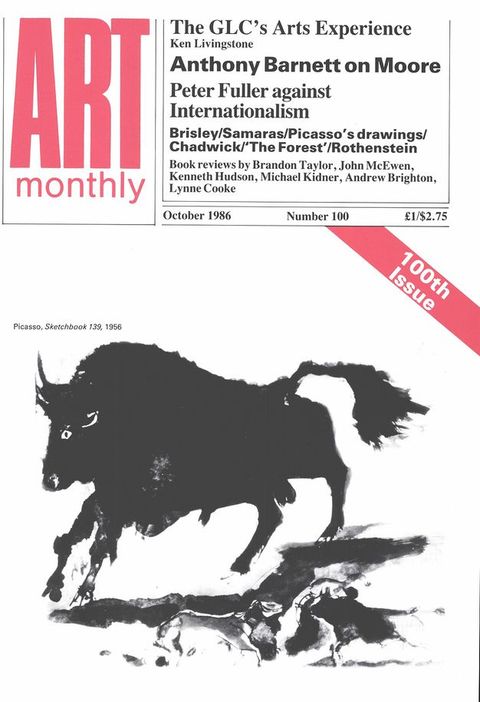
In “Clearing a Space for Criticism”, Fuller argued that an editorial commitment to exposing the transitory and transactional relationship between the market and history on the perception of art would strengthen critical discourse.73 Such processes of demystification could only be performed by a critic prepared to “search for the contradictions in his own perception”. The contradiction of Modern Painters was its marginalisation from the contemporary art world, of which Fuller had previously been a part. Launched during a wider economic recession, many of the aforementioned smaller magazines had ceased publishing and editorships had changed. Faure Walker had left Artscribe, before it added International to its title; Brian Sewell had replaced Richard Cork as art critic on The Evening Standard; and there was a return to painting in the neo-romantic style, as seen in the galleries of both the Royal Academy and Bernard Jacobson, who backed the magazine financially. Having left behind the politics that had motivated his original critical reflection, Fuller’s first editorial, titled “A Renaissance in Art?”, noted through an indiscriminate citation of statistics a wide “public indifference” to the art and culture he considered a “sham”, and levelled similarly arbitrary criticisms at Artscribe International, citing subscription and circulation numbers without context. Using the first issue to settle some scores by inviting Matthew Collings, until recently editor of Artscribe International, to engage in a “self-interview” by responding to prompts from the magazine, the article instead revealed a continuing ambivalence to Fuller’s ideas of a British “traditional sensibility”. By declaring that any art-viewing audience would be able to consider these ideas for themselves, Collings echoed the same sentiments voiced by Faure Walker a decade earlier. Fuller’s turn to tradition in Modern Painters foreclosed the critical space his earlier writing had attempted to clear. Sir Roy Shaw’s article, “Art for Whom?”, reiterated the tensions related to the exhibition of the same name at the Serpentine in 1978, and created a jarring sense of disconnection from the proposed “public” audience and the readership being served by such retrospection from the establishment by inviting the former secretary general to reflect on the current state of the Arts Council. As Fuller’s vision of a radical tradition celebrated in the present failed to find purchase beyond the pages of the magazine, the possibility of a British art renaissance, couched as a question in the title of his editorial, remained unaddressed.
73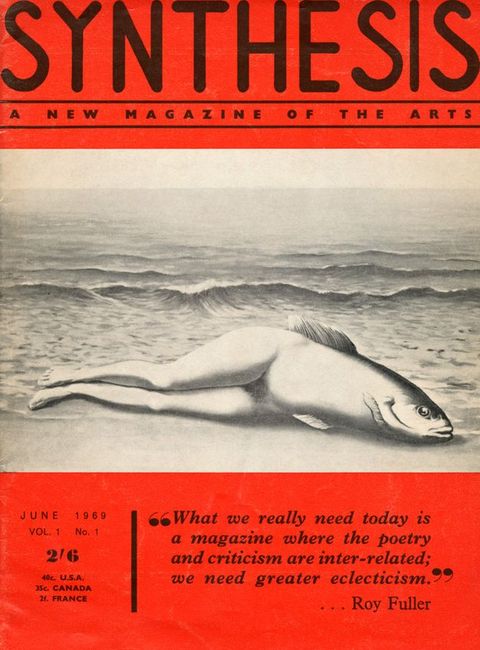
Fuller’s editorship of Modern Painters was short, and the launch of Frieze magazine in 1991, along with the YBA movement almost subsumed any other articulations of this period. The deregulated and devolved artistic mainstream of the 1990s navigated a route that in its disavowal of Marxist institutional critique for entrepreneurship, mined the commercial “free” market for potential. In 2006, after a period of investment by the state in the “culture industry”, Frieze revisited the questions originally posed by Studio International in 1976 to see what had changed. Finding again a publishing environment that had critically failed to address the economic conditions of those involved as contributors, Richard Cork, invited to comment on the results, said: “As a critic myself, I ended up wondering how anyone without a salary or a trust fund can possibly afford to write for art magazines at all”.74 Modern Painters wasn’t Fuller’s first magazine. In 1969 he had launched Synthesis: A New Magazine of the Arts, with the accompanying editorial note: “We want to break down the tyranny of the closed, critical circles and the facetious escapism of the underground press, which in their different ways, are at present preventing the objective observer from seeing what is happening in the arts” (fig. 11).75 Combining poetry and fiction writing alongside features on David Hockney and on the film-makers Lindsay Anderson and Jean-Luc Godard, the magazine, in its attempt to explore underground scenes along with those involved in more commercial ventures, sounds not dissimilar to the publication space Fuller himself wrote about in 1976. Synthesis, as described by J. J. Charlesworth, was a magazine “where the counterculture and the mainstream coincided”. Just as Cork failed to recognise his own agency in relation to an art world in crisis, perhaps Fuller, having disavowed his radical past, refused to understand that he had already produced the critical space he so desired.
74Contribution by
-
Moran ShelegLeverhulme Early Career Fellow, School of History and Art HistoryUniversity of East Anglia
A Ruskin Effect?
Art historians may at times feel discomfort, even disaffection, with the ideologies underpinning the foundation of their discipline. Yet rarely does this discomfort amount to a bodily shudder. Such is the visceral reaction brought on by the first few pages of the inaugural issue of Modern Painters, at least for those scholars (myself included) invested in the study of modernism and its aftermaths as a meaningful and urgent pursuit. Maybe spurred by masochism, or some morbid curiosity, one perseveres and reads on to the final line of Peter Fuller’s founding editorial and is left with a queasy sense of déjà vu: “Good art can minister to the human spirit even in these troubled times”.76 The taste of a past memory floods the palate and threatens to engulf all around it. A figure looms on the horizon ushering in an attempted return to the missives of John Ruskin, as so unsubtly proclaimed by the journal’s chosen title, and lowering the pale of a particular brand of 1980s neo-Romanticism with all its nationalistic shades and name-calling spite.
76Over 100 years earlier, Ruskin’s notoriously unwieldy, rambling, and almost wildly ambitious multivolumed Modern Painters (1843–60) attempted to demonstrate the superiority of contemporary painting whose primary subject is nature over all art of the past. Ruskin was referring, in his problematically sweeping assessment, to the mature work of J. M. W. Turner, an artist whom he lauded as the “third star” (alongside Shakespeare and Verulam, also known as Lord Bacon) “in the astronomy of intellect, [round which] all other stars make their circuit” and whose rehabilitation was long overdue.77 Ruskin’s clarion call for a revival of “good” art’s sublimating potential for society, now something of an old chestnut, clearly appealed to Fuller’s commitment to what he saw to be an authentic aesthetic experience and a humanist propensity that had long marked his critical stance. His political proclivities had waxed and waned over the course of his career from Marxism, through psychoanalysis, and ending with unabashed conservatism. It is hard not to have a visceral response to Fuller’s editorial. Indeed, its intent is to stir the reader up (if not quite to nauseate). One’s knee-jerk reaction may be to consign Fuller to the extreme right of the historical spectrum, which is surely where he belongs. Yet, the critical bite of the ex-Marxist is evidently one that took seriously the empty promise of art’s ever-growing plurality, snobbery, and commercialism, which also troubled his leftist colleagues, as well as many art critics before him. A potential common ground emerges. And still the quandary remains: what is one to do with such an (admittedly square) enfant terrible that one would rather forget? With the chance to revisit this object and the moment in which it arose comes the recognition that such polemics have studded art history’s recent past to the extent that they constitute an alternative trajectory, one as contradictory and convoluted as Fuller’s own theoretical arc, against which the latter can in turn be positioned as a useful limit case precisely because of its relative failings.
77Fuller first encountered Ruskin’s writings as a student at Cambridge during the 1960s, and, it seems, came full circle in his thinking by the time he founded his own Modern Painters two decades later, just as the mood around painting was turning. A roster of high-profile middle-aged white men were invited to contribute to the inaugural issue, whose historical subtext is one of generational scepticism as much as nationalistic bravado, political chauvinism (across the spectrum), and aesthetic bias against abstraction. Their shared outlook, while directed at the climate of taste-making that was abhorrent to most of them, was rooted in history, recycling many old tropes to further its programme, not least its attempt to re-establish the importance of the dissenting critic (as much as the artists, art, and point of view they championed) in a context of apparent cultural degradation, ignorance, and miseducation—yet another justificatory and authoritative idea emanating from the opening pages of Ruskin’s Modern Painters.78 It is interesting to note too how the anti-Americanism of Fuller’s sentiments also echoed British curator Bryan Robertson’s own about-face around 1967, when the one-time champion of contemporary abstract art and director of the Whitechapel Gallery dismissed Frank Stella’s Moroccans series of neon-hued stripe paintings as “art deco” over art proper, in his own way weaponising (if inadvertently) one of modernism’s oldest and most severe aesthetic sins, ornament. This was to prove a particularly touchy subject that would take on an increasingly ironic tenor by the late 1980s, a point I shall return to shortly.79 Another major concern for Fuller, as he states with his characteristic frankness, was the increasing cultural power of institutions such as the Arts Council and Tate over the public consumption of art. Echoing Ruskin’s chastisement of the public-funded sponsorship of architecture that failed to enlighten the masses, for example the reconstruction of the Crystal Palace at Sydenham in south London (1854), he accused these institutions of regularly propping up undeserving examples of sinful excess.80 When Roy Shaw, a former secretary-general of the Arts Council who had resisted the Tory government’s cuts to arts funding in the early 1980s, and who valued Ruskin as a precedent in the fight for democratising the “right” kind of art education, commented on this situation in his text “Arts Council Art”, he further upped the ante.81 The inclusion of Benoit Mandelbrot’s exposition on fractal geometry also, rather heavy-handedly, tapped into a seemingly objective adherence to “truth to nature”, another Ruskin-inspired, if somewhat puzzling, turn.82
78Given this complex mesh of echoed grievances and assertions, Fuller’s invocation of Ruskin’s opposition to “the way in which laissez-faire capitalism was destroying the aesthetic dimension in human life”, as laid out in The Political Economy of Art (1857) in no less paradoxical a fashion— being equal parts socialist and conservative—could be seen as both misguidedly reactionary and uncomfortably relevant.83 (Its relevance is perhaps all the more striking and uncomfortable now, given the current polarising transatlantic climate.) Although Fuller claimed that Ruskin’s stock as a “cultural voice” had been non-existent during the 1960s, the latter’s reception was to be felt across a diverse range of responses to this heightened situation, particularly by the artists who emerged during this pivotal decade.
83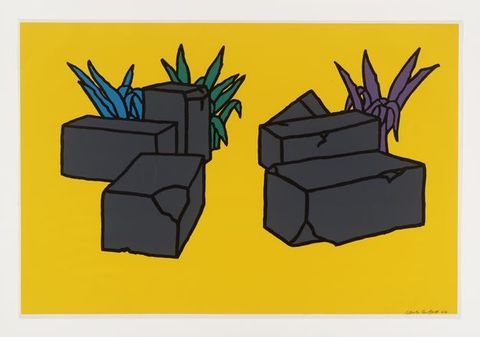
In 1986 Patrick Caulfield was invited to curate a small display of paintings from the National Gallery’s collection, as part of a series of artist-selected exhibitions. A painter who had, since the early 1960s, probed the underside of Romanticism and posed its ruination (at times quite literally) in his paintings (see fig. 12), Caulfield too seemed drawn to Ruskin as a key representative of a type of aestheticism that, although hopelessly old-fashioned, lingered in the contemporary vernacular. His selections for The Artist’s Eye speak of a savviness about such legacies of nostalgia and a desire to shake them loose from their moorings. His choice of the landscape paintings on display, including Turner’s unfinished work The Evening Star, were guided precisely by their “Romantic” quality, which he defines as “a picture that has a mood” (fig. 13). In the case of the Turner, he identifies the abstractness of the white dabs that indicate the star’s reflection and the pronounced divide between sky and sea as key details that give the painting its sense of “pictorial space”.84 Caulfield’s own Lunchtime, painted in 1985, hung alongside his choices, all of which seem to convey some sense of this space despite diverging hugely in terms of period, technique, style, and subject matter (fig. 14).
84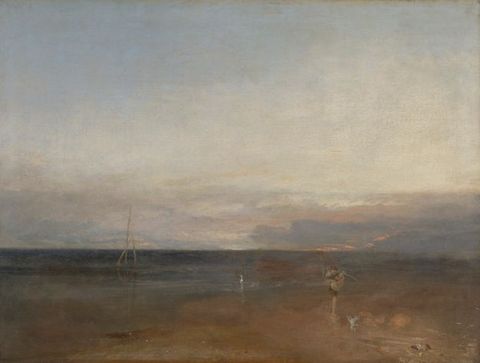
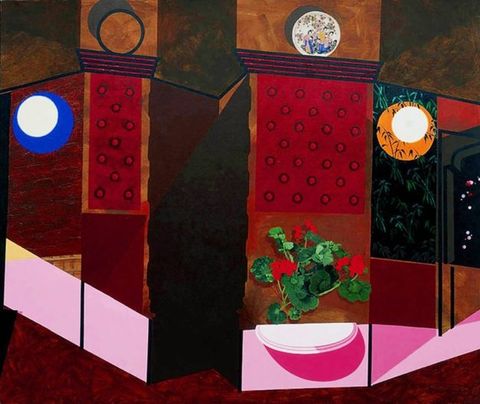
Knowingly antithetical to traditional notions of the sublime, and of nature as the highest form of beauty, Caulfield’s words nevertheless chime with the emphasis on the often tenuous link between means and ends in painting.85 By this time in his career, Caulfield was exploring painting’s very structure as to do with interiority—in the sense both of the interior of a physical space and of painting as a world within a world—which was achieved through the juxtaposition of all manner of techniques. Although he gloried in kitsch and ornament from the outset of his career, Caulfield spent hours at the Victoria and Albert Museum copying its many imperial treasures, one of which appears in Lunchtime as a chinoiserie plate hung high above the plant-strewn demilune tabletop raked with flat pink rectangles of midday light, adding areas of impasto and texture to his previously flat, matte compositions. Ironically, it was exactly the apparently seamless elision of such disparate styles and sources in his earlier paintings, for example Artist’s Studio (1964), that led Fuller to deem Caulfield’s “boring and bland” world view as complicit with “the ideology of the mega-visual tradition”, by which he meant popular capitalist culture, that dogged British art and brought about its decline during the 1970s (fig. 15).86 It seemed little had fundamentally changed in Fuller’s thinking or in Caulfield’s practice by the mid-1980s. Yet, by placing these conceits in direct conversation, Caulfield suggests that the expressive style, which disingenuously lays claim to more truthful forms of beauty and its attendant “symbolic order”, favoured by critics like Fuller, is just as problematic and compromised as any other. This was not least in light of the “return” of gestural figurative painting on both sides of the Atlantic by this time, which highlighted the dangers of a national style of proclamatory rhetoric, such as that in Fuller’s review, published in the second issue of Modern Painters, entitled “The Last Romantics: The Romantic Tradition in British Art, Burne-Jones to Stanley Spencer”, in which he defended John Christian’s 1989 exhibition of Pre-Raphaelite art at the Royal Academy.87 While Fuller lambasted the American painters who laid claim to expressionistic traditions, such as Julian Schnabel, he nevertheless sought out a brand of “Englishness” in painting and sculpture that upheld “spirituality” and “symbolism”, often at the expense of any analysis of the material qualities of individual works, which had of course been a key focus for Ruskin.88 Choosing Ruskin’s political pitch rather than using his analytical eye, Fuller seemed to lack Ruskin’s sensitivity towards the art he championed.
85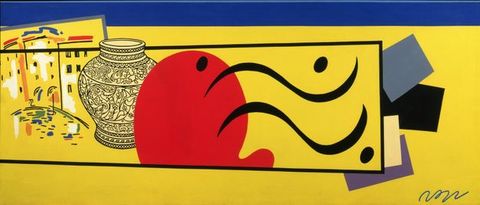
Another target of Fuller’s later ire, Bridget Riley, had an equally sustained, if comparatively understated, involvement with what might be called “the Ruskin effect” permeating British art since the 1960s.89 As an artist dogged from the outset by the commercial exploitation of her work, Riley was no less invested in the formal qualities of painting and their potential to transcend mere spectacle (if only in theory).90 At first she won praise from Fuller, in a 1971 review of her Whitechapel restrospective, as an enterprise that attempted to “explode elitist barriers” by opening up visual experience “far beyond the confines of Fine Art”, despite its “anachronistic” adherence to the “supremacy” of the “individual work”—an analysis that betrays Fuller’s earlier allegiance to Benjamin-inflected materialism.91 Like Ruskin, Riley often spoke of nature as a guiding principle for the kinds of visual sensations animating her work, despite its associations with industrial technology and optical trickery, which were often reinforced in critical accounts.92 In conversation with E. H. Gombrich in 1994, Riley directly discussed Ruskin’s likening of colour and its use in painting to music as an apt description of a parallel means of providing “a vehicle for those things which cannot be objectively identified but which can nevertheless be expressed”.93 Riley applied this specifically to abstract painting and her own meticulous process of building up a surface of geometric units governed by a set of opposing dynamics found in nature, such as “repose, disturbance, repose”. Ruskin’s discussion of colour in his treatise on drawing, essentially a manual for the aspiring draftsperson, is led by the rule of relativity, of a balancing of areas within a composition based always on an observable element of the landscape.94 Riley’s statement, “Working with Nature”, written in 1977, echoed Ruskin in her search for such “delicate and elusive” effects or “colour reactions”, removed from the “Romantic legacy of expression” or of landscape proper. It was an approach directly informed, as Robert Kudielka notes, by “the English 18th-century view of nature as energy which inspired the English country garden and the painting of Constable and Turner”.95 As an artist who works primarily in drawing, with her subsequent paintings completed by assistants in a workshop-like manner so as to eliminate any remnant of gestural signification from their facture, this resonance appears all the more suggestive.
89Displaying as much cynicism towards Romanticism as Caulfield, Riley would, however, take the opposite tack, exploring painting’s vestiges as a means of capturing the external appearance, often filtered through the lens of experience, that marks out her work as part of the so-called phenomenological turn in mid-century art.96 Memories of encountering the natural landscape both directly and indirectly pepper her writings, as when she recalls being mesmerised as a child by the dispersed, shimmering patterns of light while submerged in the Cornish sea, which she likens to the sensation of “swimming through a diamond”; or her first visit to the ancient pyramids of Giza in the winter of 1979, within whose networks of richly decorated burial chambers she saw a palette and rhythm of colours that seemed to “embody” the “brilliant North African light” beating down on the desert beyond.97 Following this visit, Riley made a series of paintings, including Winter Palace (1981), composed of sets of coloured lines of oil paint approximating the colours she remembered from these sites, whose effect could be said to transport the viewer’s spatial understanding of their immediate context into another, less locatable, locale, while playing off the vicissitudes of memory as a creative principle (fig. 16).
96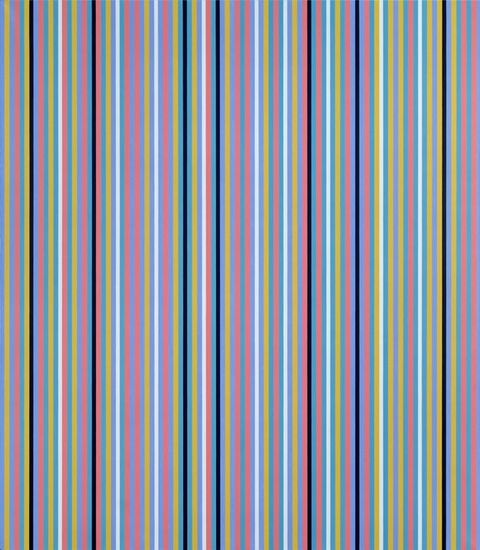
Riley’s emphasis on the power of looking aligns with a historical emphasis on opticality that troubled later critics of Ruskin, most notably Rosalind Krauss, who memorably portrayed him as a pale, sheltered infant fixated with the patterns of crawling ants and wallpaper brocades festooning his lonely but privileged middle-class existence.98 While he is cast as a straw person in Krauss’s attempt to uncover the “optical unconscious” underpinning modernism as a counter-current to demands for art’s visual veracity, this version of Ruskin also conjures up a figure that is crucial to Riley, Marcel Proust, whose own relation to Ruskin was being re-evaluated towards the end of the 1980s. Another sickly child obsessed with patterns and sensorial experiences, Proust himself turned to Ruskin as an example of an eye in search of the meaning that form might reveal over time.99 Although, as some scholars have argued, Proust would have to overcome his devotion to Ruskin to produce the definitive artwork of his lifetime, À la recherche du temps perdu (1913–27), at the very end of the novel he seems to echo this earlier lesson, when his narrator describes the work of a writer as one of “translation”.100 It was exactly this element of Proust’s opus that Riley later (during the 1990s) pinpointed as its kernel, which for her doubled as an apt analogy for the work of the painter: “An artist is someone with a text which he or she wants to decipher”.101 While it smacks of an already outdated semiotic approach, Riley is here referring to Samuel Beckett’s 1931 essay on Proust, in which he examines another writer’s view of creative work to “find a basis from which to develop” as a young writer himself, in a talk delivered to art students at the Slade School of Fine Art in London. Hence from this chain of recycled thought emerges an amalgamated version of Ruskin—careening between the preachy polemicist, the devout student of nature, the educator, the hopeless Romantic, the “innocent” eye, and so on—shaped through a historical game of broken telephone.
98All this is to say that Fuller’s Ruskin, or the Ruskin formed through Fuller’s invocation, while perhaps the noisiest, was not the only or the most productive one available. On the contrary, there seem to have been several conflicting yet potentially viable options, which together suggest that a message can be received many years after the fact, as Thierry de Duve has noted, even amid “signs of resistance to that message”. Here de Duve is referring to the implications of Marcel Duchamp’s “readymade” permeating mid-twentieth-century art—or, rather, the syllogism animating it, that “when a urinal is art, anything can be art; and when anything can be art, anybody can be an artist”—and to its rejection by figures such as Robert Smithson, who also occasionally referred to Ruskin, with whom he shared an interest in ecology and a preoccupation with ruins even if in a different, and at times counter, register.102 And this can hold true even in responses that, having received this message, refute its logic, which leads one to wonder: What would be the Ruskin syllogism as variously received—or resisted—by the time of Fuller’s “translation”, as it were, in his own Modern Painters manifesto? Certainly, the idea that, when truth to nature is adhered to, culture can be saved, and when culture is saved, humanity is redeemed rings too hollow, too naive, and too utopian to be taken seriously. Yet, within the vagaries of these founding terms of “nature” and “truth” lies the very potential that later allowed critics such as Fuller and artists such as Caulfield and Riley—and others besides—to invoke, revoke, and reimagine the forms such a syllogism might assume materially, particularly at a time when British art and its institutional representation were coming under unprecedented pressure to compete on a global stage or else perish in provincialism.
102Contribution by
-
James Baggott-BrownSenior Lecturer and Subject Coordinator in Critical StudiesBath Spa University
Peter Fuller and the Spirit in British Painting: “Nature and Raw Flesh”
By the time the first issue of Modern Painters was published, Peter Fuller had already set out his rejection of modernism in some detail.103 In his editorial to this issue, he placed the “best” British art in opposition to what he portrays as the failed modernist project, arguing that “in Britain refusal, rather than acceptance, of modernity has often provided the greater creative stimulus”.104 Modernist painting and sculpture, as far as he could see, had moved away from values he considered central to powerful art. Modernism’s legacy was a generation of artists with “nothing to say and no way of saying it”.105 This was no more evident than in the United States, where he saw Jackson Pollock as modernism’s most iconic failure, through the painter’s inability to address the twin threats of the twentieth century’s “saga of atrocity” and the advance of the “mega-visual tradition”.106 For Fuller there was an “underlying human condition, which is determined by our biological rather than our socio-economic being, by our place in nature rather than our place in history”.107 This would help to explain “the fact that, in Christopher Caudwell’s phrase, ‘great art … has something universal, something timeless and enduring from age to age’”.108 Fuller was identifying a deeper, more complex relationship between the viewer and the work that connects all humans on a biological level.109
103In the first part of this article I set out Fuller’s critical position in relation to key writers who helped shape his particular form of spiritual humanism. I then address his own article, in the first issue of Modern Painters, on the English painters Graham Sutherland and Francis Bacon, in which he aligned both artists with a European tradition of painting “for which religious symbolism and belief were of central importance” and “eccentric to Modernist concerns”.110
110In his editorial in the first issue of Modern Painters, Fuller argued that “the best British artists have stubbornly maintained the traditions of an aesthetic rooted in the human figure, and, indeed, in the imaginative and spiritual response to the whole world of natural form”. He included in this both “higher landscape” painting and the painterly abstraction of nature. Fuller’s argument, put simply, was that “there have been major painters and sculptors in Britain, this century, whose work requires no apology in comparison with the highest artistic achievements of Europe and America”.111 He suggested that, rather than looking to Europe or the United States, the best British art had displayed an “informed, and often intransigent, insularity”.112 What he was identifying, then, was a specifically British tradition within which the “best” work of recent years had been produced. He suggested that the strongest British art of the 1980s had developed out of “a history of almost three centuries”, and identified “continuities which link Hogarth and Reynolds to Freud and Bacon, or Constable to Auerbach”. Also implied here was that the influences on such work were pre-modern. Fuller identified “a revival of British higher landscape painting which may prove as significant as the neo-romantic resurgence of the late 1930s”.113 Thus Fuller set “higher landscape painting” as potentially the most important form of art of the recent past.
111In an article published posthumously in Modern Painters following his death, Fuller explained in detail the development in his aesthetic tastes that had ultimately informed the editorial position of the magazine. He identified particularly with Ruskin’s distinction between aesthesis and theoria, “the former being merely a sensuous response to beauty, which he identifies with modernism, the latter a response to beauty with ‘our whole moral being’”.114 Ruskin, therefore, provided Fuller with a connection between the aesthetic qualities of the work and the higher purpose of moral and spiritual development. He saw Pollock’s failure, for example, as the failure of modernism to provide a subject matter through which to channel his “considerable abilities”.115 In this sense at least, modernism had failed. To be successful, Fuller believed, the best contemporary art looked back beyond the modern to a tradition that would provide a more meaningful connection to the world, to life, and to the spirit.
114Fuller’s writing developed accordingly and started to focus on British (largely but not exclusively English) landscape painting and how it “faced up to the aesthetic consequences brought about by the spiritual dilemmas of the modern age”.116 He stated that he “became interested in the links between natural theology and the triumphs of British ‘higher landscape’, and those beliefs about nature as divine handiwork which were held with a peculiar vividness and immediacy in Britain”.117 It is likely that natural theology provided Fuller with a spiritual belief system that was close to that of Ruskin, who found the work of God in nature, and allowed for his critical agnosticism, which was rooted in a lifetime of theological debate with his father.118 It was through Ruskin that Fuller described his own conception of natural theology. In his book on Ruskin, Theoria, Fuller described Ruskin’s insistence that “the ‘work of the Great Spirit of nature’ was not only to be detected in the exultations of the mountains; it was, he said, ‘as deep in the lowest as in the noblest objects’”.119 Indeed, Theoria demonstrates Fuller’s deep engagement with natural theology and its adherents, particularly those who brought scientific knowledge to bear on their conception of God and his work. For example, Fuller seemed particularly taken by William Buckland’s description of geology as “the knowledge of the rich ingredients with which God has stored the earth beforehand, when He created it for the then future use and comfort of man”.120 Fuller almost certainly did not believe in God in the sense that Buckland, or indeed Ruskin, did but, in finding God in nature, their versions of natural theology matched his own most closely.
116In a lecture of 1990 Fuller suggested that “Ruskin was onto something fundamental when he argued that what Turner reveals about nature does not stop at appearances but reaches through and beyond them to a spiritual vision of nature itself”. Fuller extended this observation beyond Turner, arguing that “the truths which the higher landscape painting of the early nineteenth century struggled to express were not simply ‘natural’, let alone merely ‘visual’. They were religious and spiritual”.121 It was in the legacy of Turner and of British “higher landscape”, then, that Fuller found an answer to the spiritual lacuna left by modernism.
121Ruskin preferred work that presented nature as “God’s second book … a physical revelation of Himself”.122 Ruskin was obsessed by the wilderness as a “place of desolation”. Fuller, like Ruskin, believed the Pre-Raphaelites to have been central to the history of British art.123 William Holman Hunt was singled out in particular for his Eden-like landscapes. However, it is the manifestation of Hunt’s experiences of the Holy Land in his paintings that were of particular interest to Fuller, not least The Scapegoat which, quoting Hunt himself, Fuller described as “so extraordinary a scene of beautifully-arranged horrible wilderness”, when what Hunt had hoped to find was “material evidence of his redeemer”. Following Ruskin, Fuller claimed that “the image of a wasteland and its redemption, its transformation into new images of paradise, has been the subject of the best British painting ever since”.124
122Of course, other critics were also celebrating British landscape painting. Before he wrote for Modern Painters under Fuller, the painter Roy Oxlade had already written several articles and essays on his former tutor, David Bomberg, in terms similar to how his editor would later also write about the same artist and other neo-Romantic landscape painters.125 Richard Cork shared a similar viewpoint and wrote a number of catalogue essays, as well as a monograph, on Bomberg, again with a focus on the painter’s notion of the “spirit in the mass”.126 Fuller was thus not alone in his celebration of the British landscape tradition towards the end of the twentieth century, but reflected a prevalent, if marginalised, tendency.
125Fuller’s feature article in the first issue pitched the work of two twentieth-century British painters, Graham Sutherland and Francis Bacon, against each other. Tellingly, the article began with a quote from Douglas Cooper, the author of a 1961 monograph on Sutherland, who claimed that the painter “is the most distinguished and the most original English artist of the mid-twentieth century”. Asserting that “Cooper certainly intended to imply Sutherland’s superiority to Francis Bacon”, Fuller went on to argue for just that, in spite of what he characterised as the unjust “contemporary evaluation of Britain’s two major post-second world war painters”.127
127This characterisation of Bacon’s and Sutherland’s recent reception as unjustly negative was notable and, I would suggest, inaccurate. Reviews of John Hayes’s book on Sutherland, published in 1982, routinely celebrated the painter’s oeuvre. Even the critics for whom Sutherland’s portraits were of less value generally agreed that his landscapes remained “potent images of the primitive in ourselves” and that Sutherland “can forcefully capture the imagination of the beholder”.128 Equally, reception of Bacon’s work continued largely to be positive, even laudatory.129 Indeed, the headline for an article in The New York Times stated that “Time Vindicates Francis Bacon’s Searing Vision”.130 Perhaps Fuller’s defensiveness here was the result of a combination of one or two more negative responses to Sutherland and Bacon, and of having been disproportionately distracted by the promotion of work he disliked.
128Fuller contrasted Sutherland’s “yearning for spiritual redemption” and “aesthetic rooted in natural theology” to Bacon’s concern with “only sense and sensation” and “mundane sense of damnation”. Bacon, then, represented Ruskin’s aesthesis and Sutherland his theoria. In Sutherland, Fuller recognised Hunt’s “material evidence of his redeemer”. Quoting John Hayes, he suggested that “for Sutherland, landscape, and all its elements, bears the impress of the divine creation, of which he seeks to catch a reflection”.131
131As is made clear in Fuller’s editorial to issue 1, the notion of a “British tradition” rooted in “romantic landscape” would be central to the magazine’s position. In the Sutherland article, Fuller argued that the painter “fused his English nature Romanticism with what he had learned from the best twentieth-century French art, to produce some of the most original and elegiac British paintings of recent years. Conglomerate I, 1970, bears witness to Sutherland’s Ruskinian capacity to see in a pebble the grandeur and scale of a mountain range”. His interpretation of the work of this period focused equally on the symbolism of natural theology, as he explained that “Forest with Chains II, 1973, suggests the eventual triumph of the organic over the mechanical” and that “the troubled root forms of Picton, 1971–2, are heavy with presentiments of a return to the earth, of impending death” (fig. 17).132 Fuller acknowledged that Sutherland was not consciously a symbolist. Again, he returned to Ruskin, claiming that “Ruskin seems almost to have had Sutherland’s last paintings in mind when he praises the ‘infinite wonderfulness there is in this vegetation’”.133 Even in Sutherland’s most pessimistic paintings, “his responses to an injured and injurious nature, and his war work”, Fuller identified a trajectory that was building towards “the promise of salvation” to be found in more explicitly religious paintings.134
132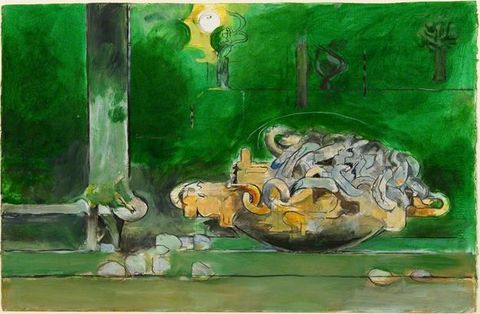
The subject of salvation is returned to again and again by Fuller and other writers in Modern Painters throughout the period of his editorship and beyond. This sense of salvation refers not only to spiritual salvation but also to a salvation from the philistinism that Fuller saw creeping into art institutions and arts policy at this time. Indeed, he described an “unholy alliance between philistines of the [political] Left and the Right”, brought on by “the left-wing aesthetic theories of the 1960s and 1970s”, which, he suggested, “provided the ‘programme’ for the right-wing governments of the 1980s”.135 He described how Margaret Thatcher’s government emphasised design education over fine art, and equated this to John Berger’s argument that “museums were ‘reactionary’ middle-class institutions”. The suggestion here is clearly that Berger’s “assault on the idea of Fine Art values, which he dismissed as ‘bourgeois’ and anachronistic”, should have been considered at least partly responsible for the “pressure” the government placed on art institutions. This link between theory and policy was made explicit when Fuller stated that “Mrs Thatcher initiated a regime of stunning philistinism and destructiveness, which aimed to sweep away the last vestige in public arts policy of exactly those things to which the Marxists had objected”.136 The work that Fuller celebrated through Modern Painters, then, represented salvation from Berger, from theory, and from the perceived philistinism that resulted thereof.
135Also in issue 1, Roy Oxlade described David Bomberg’s work as “transformative” and “redemptive”.137 In the first issue of Modern Painters published after Fuller’s death, the first major article was an interview conducted by Fuller with the Australian painter Arthur Boyd, in which the artist spoke of the “use [of] everyday landscape [tied] up with something that was either in the nature of design or of some psychological essence. In other words to bring [the figure] into this pristine paradise, or landscape—pristine in the sense of being untouched”.138 This seemed to describe the paradise that is absent in Hunt’s The Scapegoat. In the Summer 1991 issue, Howard Jacobson lamented the lack of vertiginousness in the work of the British painter Michael Andrews, contrasting it with examples of Romantic landscape painting which, through inciting a sense of vertigo, approached the “delightful Horror, [the] terrible Joy” of the sublime.139 In doing so, Jacobson, like Fuller before him, lamented the absence of divine terror from landscape painting.
137Whereas Sutherland was, like Bomberg, concerned with the “spirit in the mass”, Bacon’s work was of the flesh, bringing “extreme anatomical and physiognomic distortion as the principal means of expression; a general tenor of violence and relentless physicality … to an abandoned tradition of Christian religious painting”.140 Although Fuller pointed out that Bacon shared the iconography of the crucifixion with Sutherland, he “insist[ed], however, that [Bacon’s] interest in the subject has nothing to do with its symbolic resonances—least of all with any hint of salvation”.141 Although he did not explicitly state a judgement between the two approaches at this point, Fuller’s concern with painting as redemption from Matthew Arnold’s “long, withdrawing roar” of the “Sea of Faith” would suggest that his preference was for Sutherland’s search for salvation rather than Bacon’s more base treatment of the subject.142 A comparison of Bacon’s Painting 1946 with any of Sutherland’s crucifixion paintings—for example, Thorn Trees—reveals the central differences in approach that led Fuller to his preference of the latter (figs. 18 and 19). Where for Sutherland the crucifixion iconography consists of nature’s lush greenery against a bright blue redemptive sky, Bacon presents the viewer with a pale meaty cadaver, butchered and hung in a flesh-coloured room before closed blinds.
140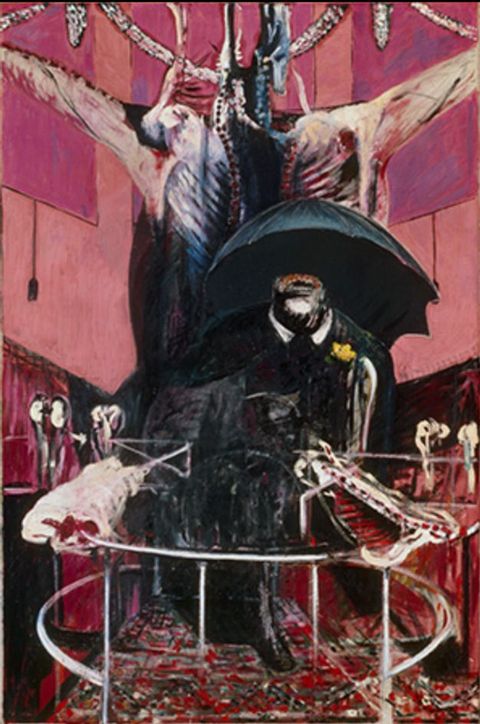
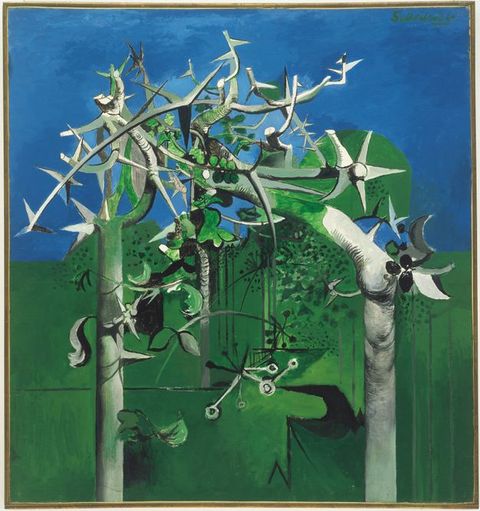
The reason for the gradual collapse of Sutherland’s reputation, Fuller suggested, was the replacement of “the ethics of hope and ‘reconstruction’” with “the callous banalities of consumerism”. This statement reflected the argument he also put forward in the editorial to this issue, that the institutions in positions of power within the British art world—including other magazines—had turned their attention away from his preferred traditions, towards the “emptiness of … Late Modernism” and the “anarchy of Post-Modernism”, and saw the notion of a national tradition as “aberrant”. What he saw in its place was an internationalism that promoted a “tacky preference for the novel and the fashionable”.143
143For Fuller, however, the problem was not simply the growing irrelevance of Sutherland’s subject matter in an increasingly consumerist art world, in which “his Risen Christ seemed like an iconic survival from a forgotten age of faith” but, rather, the misguided attempts of the art world and artists to respond to such changes.144
144Sutherland and Bacon’s work were therefore antithetical not only to the failures of modernism but also to the “anaesthesia” of contemporary art after pop, as exemplified by Gilbert & George, Fuller’s bêtes noir throughout his editorship of Modern Painters.
In Sutherland’s best work, Fuller argued, “he seems to affirm the intractable, unmalleable ‘otherness’ of the world of natural objects. And yet he insists, like Ruskin before him, upon the necessity of an imaginative, spiritual, and aesthetic response to nature, regardless”.145 Under Fuller’s terms Sutherland was the more successful artist because his paintings “celebrate the potentialities of a human relationship with the natural world beyond the water-closet”.146 Although it is clear that Fuller was comparing Sutherland with Bacon here, I would suggest that he probably also had in mind the work of the Young British Artists (YBAs), who at the time he was writing, were building space for themselves around London, inhabiting previously empty buildings in Hoxton, Kennington, and Docklands.147
145This notion of human potentiality ran throughout Fuller’s writing on art after his rediscovery of Ruskin. This article, as much as any other in the first issue of Modern Painters, made absolutely explicit the nature of the magazine, the reason why it bore the title of Ruskin’s own master work, and what set it apart from other art magazines that were around at the same time or that were established soon after Modern Painters was founded.148
148Contribution by
-
Kevin LoteryAssistant Professor of Modern and Contemporary ArtBoston College
The Critic Laughs
The Entrepreneur
Though it first appeared in The New Republic in December 1987, Robert Hughes’s essay “Julian Schnabel: The Artist as Entrepreneur” was originally commissioned by Peter Fuller for the inaugural issue of Modern Painters.149 Ostensibly a double review of Schnabel’s mid-career retrospective at the Whitney Museum of American Art and the semi-autobiographical book CVJ: Nicknames of Maitre D’s & Other Excerpts from Life (1987), the article was actually a more thoroughgoing polemic that took aim at the entrepreneurial ethos Schnabel embodied within the supercharged art market of the 1980s. This was a market, Hughes reminds us, nostalgic for “big macho art”: large-scale, mostly figurative painting by young (male) geniuses, Schnabel foremost among them.150
149In 1986 Fuller had himself penned his own venomous takedown of Schnabel, and he likely turned to Hughes the following year, knowing that his famous friend’s similarly “rancorous” model of art criticism could produce a provocation equal to his own.151 Here was an opportunity to position the aesthetic ideology of his fledgling magazine within the polemics surrounding neo-expressionism and the globalization—read the Americanization—of art and its markets. And only Hughes, Fuller undoubtedly reasoned, could fit the bill.
151The first lines of Hughes’s text draw the reader into the fray, and things are, from the outset, undeniably personal. “Last year”, Hughes relates, “I took myself out of Julian Schnabel’s memoirs” (35). He claims that Schnabel had fabricated a story about an encounter between the painter and an art critic named “Richie or Robbie Huge”. And, despite having convinced the publishers of CVJ to remove the entire section prior to going to press, Hughes nevertheless opts to include it, presumably in its entirety, in the very first paragraph of his review.152 What we read there is Schnabel’s account of having been accosted by a “cockney” (Hughes was an Australian expat based in the United States), who appeared to proposition the painter under the guise of an intention to “write about” his work. “Will you chain me up?”, whispers Huge, before being turned away in “shame” and threatening retribution. It ends with Schnabel inflicting one last act of derision: “Reading [Huge’s] antisemetic [sic] babbling and personal attacks on me in Space [Time] magazine I found out he is a man of the world”.
152In his review, Hughes takes up Schnabel’s mixture of personal and ideological attack, and heightens its masculinist erotics of mastery and degradation to a grotesque degree. It was “weird enough to be called anti-Semitic by a man who couldn’t spell the word” but perhaps not surprising, Hughes continues, from a painter who “[wrote] his memoirs at thirty-five”, a “record for premature retrospection”. Note, first of all, the explicit lack of response to the accusation of anti-Semitism and also the sneering rhetorical positioning, which seizes authorial control from the painter (who, it should be noted, is Jewish). Having successfully censored the text, the tale is now the critic’s to recount, misspellings and all. The function of the critic, it seems, is to retain the last laugh, a sentiment, I argue, that is also central to the kind of art criticism Fuller hoped to promulgate in Modern Painters.
After the laughter, however, Hughes’s polemic moves on to grander ideological stakes. Schnabel’s fraudulence, he writes, must be attended to because it is emblematic of an inflated “American art system”, powered by a paranoid desire for “newness … as a value in itself” (36). Hughes writes that this entrepreneurial, speculative approach to art has led us to a distorted perspective on what and who matters in contemporary art. To the American tastemaker, “today’s klutz” (35) was so much potential capital to be gambled on, even if, like Schnabel, he had “never learnt to draw” (39).
Fuller’s earlier text on Schnabel staked out a similar position. Bemoaning the painter’s “lack of craftsmanship”, Fuller found only “a noisy emptiness”, an eclectic pastiche of styles and art historical references that had internalized the commercial ethos of “American aesthetic and spiritual life”.153 It is this kind of postmodernist “anarchy” that Fuller similarly attacked in the inaugural editorial of Modern Painters, subtitled “A Renaissance in British Art?”154 There, as elsewhere, Fuller’s reactionary diagnosis of the “noisy emptiness” of an American cultural condition could take on biomedical overtones, figuring as “sickness” or “General Anaesthesia”.155 It would be Modern Painters’ task to prescribe a grand “refusal” to this condition, one available, however, only to those properly schooled in an “aesthetic rooted in the human figure”.156 British art, Fuller argued, had the unique opportunity to position itself at the vanguard of this “renaissance” cum return to order, thanks to its spiritual attachment to the figure and the representation of nature: “the whole world of natural form”.157 Here, then, was a nativist poetics of identity rooted in an appeal to nature, nation, and spirit, the bread and butter, in short, of all returns to order, which always seek ways to expunge avant-garde strategies of deskilling by reinstalling privileged mediums of aesthetic production, painting most of all, and traditional modes of technical skill, academic training, figuration, and individual expression. Fuller’s (and Hughes’s) great “refusal” should be seen less as a radical negation in the lineage of the avant-garde than as a reactionary affirmation of tradition masquerading as its opposite.158
153Many critics on the Left, such as Benjamin Buchloh, Hal Foster, and Craig Owens, also saw neo- expressionism as a creature of a globalizing neoliberal art market.159 Rather than return to tradition, however, they looked to contemporary strategies of appropriation, deskilling, and institutional critique—techniques they saw as better equipped to critically absorb, research, and intervene in the conditions of a neoliberal order of free-floating capital, images, and signs. And they were far more adept at analyzing how the new bad boys of painting—Schnabel included—mobilized faux naïveté, irony, and self-parody as cover for their continued investment in the privileges of easel painting and the patriarchal model of the “master”. Parading so many American, Italian, or German takes on the “new spirit” of painting, Sandro Chia, Francesco Clemente, and Schnabel, to name a few, could figure their opportunistic return to easel painting and their rejection of the deskilled and decidedly intermedial practices of conceptual art or institutional critique, not as the affirmative capitulations they were, but as pseudo-critical acts of ironical transgression. Owens was especially keen to unpick this operation, in all its opportunistic inversions: “What we are witnessing”, he writes in Orwellian fashion, “is the emergence of a new—or renewed—authoritarianism masquerading as anti-authoritarian”.160
159The case of Modern Painters and neo-expressionism confirms that this “masquerade” and the humiliating laughter it permitted not only animated reactionary art making and criticism alike, but that it did so even, perhaps especially, when the critic and the painter—Hughes and Schnabel, in our case—seemed to position themselves in opposition. The vitriol, in other words, is all performed. It disguises a hidden truth: that painter and critic shared an investment in a larger painterly and discursive economy of power and affirmation, what I will call here a “discourse of reaction”. What Hughes and Fuller failed to acknowledge, I think, was that the painter as “entrepreneur” shared the stage with other figures of this “masquerade” of authority and reaction, including the “critic”. These figures—let us call them “authoritarian personalities”—were not oppositional but complicit with a larger system of power and prestige.161
161In his crucial early intervention in 1981, Buchloh was prescient in regard to this larger system of “regression” and “authority”. Drawing on György Lukács, he pointed to the dark secret of a cynical art like Schnabel’s, promising expressive freedom while delivering, once again, the privileged model of the individual artistic master. We are facing, he wrote, the first stage of a grander “ideological preparation”.162 Guided by art historical myths of genius, mastery, and free expression, this new art, he continued, was in the process of accommodating the spectator’s perceptual apparatus to a coming fascism. Looking back on the 1980s from a present in which fascism has unquestionably returned, we might recognize, in the polemics around Modern Painters, one example of what we can now call, following Félix Guattari and others, the “fascisization” of art and politics: the accommodation of artistic discourse to an affective economy premised on tradition and mocking contempt. It is the threefold goal of this essay to pick apart the machinery of this hectoring laughter, reassess its ramifications for the present, and locate aesthetic modes of resistance that sought to short-circuit it.
162The Prefect
For Hughes, the “American problem” was by no means limited to the art market. It had also come to contaminate even those most hallowed institutions of art and art history, the art school most of all. “Schnabel is instructive”, he writes, in revealing “what went wrong with the education provided by many an American art school in the 70s” (39). The new curricula, it seemed, had abandoned “academic drawing—the long tussle with the unforgiving and real motif”, leaving contemporary painters lacking in technical skill. Without this privileged training, artists like Schnabel had not, in Hughes’s mind, earned “the right” to undertake the “radical distortion” of tradition their “kitsch-expressionist” paintings capitalized on.
Fuller had similarly railed against the state of art schools, especially in Britain, since at least the early 1980s. Take his lecture “The Necessity of Art Education”. Initially delivered in 1981 at Newcastle University, the polemic took aim at the wide-ranging set of radical pedagogies known as Basic Design. When it was printed later that year in Art Monthly, the talk incited an extended bitter row between Fuller and the British artist Richard Hamilton, a key innovator of Basic Design alongside fellow Newcastle lecturer Victor Pasmore (both were primary targets of Fuller’s text).163
163In Hamilton’s model of Basic Design, emphasis was placed not on particular technical skills but on the dialectical relationship between acts of cognitive and material work—between, say, thinking and marking. Instead of pressing the student to develop an artistic and intellectual position within the inherited traditions, skills, or mediums of art, Hamilton sought to empower developing artists to fashion their own aesthetic strategies in conversation with existing technological conditions of mark making, image production, and knowledge creation—from the sciences to mass culture to, of course, easel painting.
In this, Hamilton’s pedagogy extended the nonjudgmental approach to all forms of cultural production—advertising, car styling, exhibition display, or abstract painting—that he and his colleagues in the Independent Group (IG) had first formulated at London’s Institute of Contemporary Arts (ICA) in the 1950s. In place of a hierarchy of artistic privilege with painting (read “life drawing”) at the top, Hamilton and his IG collaborators saw a field, or as Lawrence Alloway put it, a “continuum”, made up of equally valid forms of aesthetic experience. This horizontal “long front of culture” required that aesthetic producers of all stripes fashion their artistic subjectivity—like all postwar consumers of culture—within the full range of the “long front”.164
164Baked into Basic Design was an understanding of culture—and of the place of the postwar British artist within it—that fundamentally opposed Fuller’s nativist model on at least two levels. First, it framed the artist as a cosmopolitan, even anti-nationalist producer, in the lineage of the avant-garde pedagogies that had inspired Basic Design (Bauhaus, Black Mountain College). Second, and even more importantly, it positioned the postwar artist in critical relation to the everyday conditions of global mass culture. In “The Necessity of Art Education”, Fuller rejected both of these Basic Design tenets: on the one hand, its “wholesale rejection of the academic methods of art education, rooted in the study of the figure and traditional ornamentation” and, on the other, its seeming embrace of the “mega-visual” landscape of the mass media.165 Together, this indicated a “negative” approach that simply “mirrored” our “aesthetically sick” culture.166 If Basic Design—at least in Hamilton’s IG-inflected model—saw in mass culture a heterogeneous set of skills and practices to research and assimilate, Fuller could see only a homogeneous, degenerating force that threatened true culture with programmed consumption. A similar opposition, it should be mentioned, informed Fuller’s contemporaneous disavowal of the Marxist teachings of his mentor John Berger, particularly in regard to the latter’s Ways of Seeing (1972).167
165Fuller was programmatic in his opposition. To heal our corrupted “aesthetic dimension”, he argued, we should count on “painting and sculpture, alone”.168 In short, art schools had to reject Hamilton’s beloved “media landscape” and return to “natural forms, beginning with the figure”.169 It is worth noting here how much of recent British art history Fuller had to repress to make his case; indeed, it may be argued that this repression was structural to his position as a critic. Hamilton and his colleagues within the IG had long questioned the assumption that nature could be understood as autonomous, as somehow outside of the technological conditions of consumption and control that structured life after the Second World War. In exhibitions like Growth and Form (1951) and Parallel of Life and Art (1953), they created media ecologies in which the energies of nature and technology infused one another in generative ways. Fuller’s account, however, repressed this transgressive approach to the forces and structures of nature, instead framing those early exhibitions as straightforward affirmations of the empirical study of nature that Hamilton and his proto-Pop comrades would soon reject, opportunistically.170
168By the late 1970s, Fuller had begun to see Hamilton as the great “negative exemplar” of an artist who had not only abandoned this supposedly reverential relationship to nature but also turned away from what had been authentically “British” in his art. He had, instead, “prostituted … [his] imagination and his material practices” to the “anaesthetic means of making imagery” that structured mass culture at large.171 The last straw was the artist’s 1975 exhibition at the Serpentine Gallery, which featured recent paintings of, in Fuller’s apt description, “flowers, seascapes, and forest ‘glades’ defiled by representations of turds, toilet tissue, and defecating women”.172
171This was decidedly not the sort of figuration, let alone the sort of landscape painting, Fuller had in mind when he formulated his essentialist notion of a British art uniquely attuned to natural form. Indeed, in the series of paintings at issue, known informally as the Shit and Flowers works (1970–80), Hamilton seemed to position easel painting and its most time-honored genres and processes as anachronistic, even grotesque, practices within a natural order pervaded by capital. That said, the refined technical finish of these paintings indicated that categories such as “skill”, “observation”, and even “expression”—so dear to Fuller and Hughes—could still provide Hamilton with critical, transgressive possibilities (and we will develop some of these soon enough). But they could remain critically viable only alongside an acknowledgment of the abject demonstrations of privilege they had become. These were traditions not opposable to a culture of mass consumption and programmed desire (as the two critics would have it), but deeply affirmative of—indeed, products of—this very cultural system.
Hamilton understood early on that a postwar world of automated, throwaway pleasures managed by technological systems of consumption demanded a rethinking of the privileged individual human subject and its aesthetic conventions. Any appeal to “expression” depended, for him, on an outmoded anthropocentric model of the artist, which could still see the expressive individual human maker as somehow autonomous from, rather than linked up to, technological systems of control. As Hamilton and his IG comrades saw it, the morphology of the human itself—its growth, form, even imagination—was now in collaboration with these forces, in both nefarious and productive ways. Rather than despair, Hamilton searched for critical generative collaborations within this new order, whether in his painting practice, his exhibition design projects, or the pedagogies of Basic Design.
Here, then, was a British painter’s response to the “entrepreneurial” return of painterly expression in the 1970s and 1980s that we might directly oppose to that of Hughes, Fuller, and Modern Painters. The spiteful, deeply personal row between Hamilton and Fuller that played out in the letters pages of Art Monthly only underscored the depth of what was at stake: the contemptuous reinstatement of institutional and critical authority as a (false) “refusal” of an American neoliberal order. If Hamilton’s role in the dispute sometimes risked tilting into the territory of contempt too, it was perhaps because he could not hide his revulsion at what he called, with an acid tongue, Fuller’s “aura of [a] school prefect”—this, from a teacher and pedagogical innovator who had sought, via Basic Design, to eliminate hierarchical modes of instruction embodied by patriarchal figures like the master or the “prefect”.173
173Still, Hamilton never gave up on the time-honored, privileged technical skills of easel painting, despite Fuller’s misleading claims to the contrary. Writing of Jan van Eyck’s Arnolfini Portrait (1434) in 1978, for instance, Hamilton listed the painter’s “incredible technical mastery” as a central aspect of what he “most admire[d] in art”.174 This reverence for the divine abilities of the masters represents one of the great paradoxes of Hamilton’s oeuvre, especially when seen alongside his lifelong fascination with the deskilled, appropriative tactics of his mentor Marcel Duchamp. Hamilton is a useful foil here for precisely this reason: he shows us how a position of devotion to the traditional technical skills of easel painting could also encompass tactics of Duchampian deskilling as well as the new technical skills actually controlling cultural experience from the 1950s forward, whether those of the ad man, the aircraft engineer, or the CinemaScope projectionist. After all, Hamilton reminds us, van Eyck had been a technologist in his own time, an inventor of oil painting’s technology of imagination whose godlike technical skills could conjure alternative natural orders surpassing even divine creation itself.175
174As he was articulating his own embrace of artistic skill, Fuller, it seems, was unable to compute how an artist could maintain such an expansive approach to the full range of skilled and deskilled aesthetic production that structured the “long front”. Indeed, in their row, Hamilton appeared most incensed by Fuller’s counterfactual framing of his work as premised on a fundamental rejection of “traditional art and craft practices”. This couldn’t have been farther from the truth, Hamilton disputed, describing himself as an artist devoted to “the fine art tradition”, having “spent [his] life practising its crafts”. Fuller’s blatant misreading of his work led Hamilton to surmise that the critic’s take was not just ignorant but structural, part of a larger system of disinformation governing the discursive positioning of Art Monthly. “The publishers must share the responsibility”, he wrote, for the “ignorance”, conscious or not, of their critic. Perhaps, he continues, the editorial leadership of the magazine had been “encouraging these provocations to boost the distribution of a scandal sheet”.176 Thus, while Hamilton took aim at the larger systems and discursive networks buttressing the authoritarian personality of the “school prefect”, Fuller, for his part, sought refuge within them, threatening “legal action” in response to Hamilton’s “plaint”.177
176The Critic
We need to add one more personage to our little masquerade of reaction, one who, as Buchloh has articulated, seems to accompany all artistic returns to order: the clown, jester, fool, or in Hughes’s terminology, “klutz”. In the work of Schnabel and Chia, among others, the neo-expressionist clown often appears in the guise of the master himself, playacting an artistic subject who has lost historical agency or, as Owens writes, the ability to “create real alterations in the world”. Instead, the painter-jester is left to repeat melancholic gestures of ironic self-mockery in the court of power itself: “the artist-hero” who can become, “in the same breath”, the object of both “ridicule” and “resurrection”.178
178In CVJ, Schnabel performs some instructive variations on this cynical figure. Like a vaudeville showman, he presents himself again and again as an outsider who trips over the art system’s structures of privilege and authority, marking them, with cartoonish irony, in the process. And the procedures of painting are not spared this slapstick either. In one scene, we encounter Schnabel atop a ladder, hard at work on a large canvas. With both hands occupied in the act of painting, the artist struggles acrobatically to keep his trousers from falling. It was the “highlight of that summer”, Schnabel writes, leaving the painter “deciding whether to shoot [him]self or to laugh”.179
179Such spectacles of the master’s painterly impotence are designed to provoke the kind of cynical, erotically tinged laughter so familiar to us from the language of the prefect. Remember, for instance, the passage we opened with, the one that Hughes claimed to have had excised from CVJ prior to publication. There, we find “Huge” accosting the young painter: “Will you chain me up?” he asks Schnabel, who rebuffs the advance and later discovers, at the end of the passage, the “anti-semetic [sic]” tendencies of Hughes’s art criticism. Let us also remember the rhetorical strategies of degradation in Hughes’s response. In addition to the anti-Americanism coloring the review, there was, of course, the tactic of wresting the power of authorship and authority from the artist by publishing the passage that the critic was responsible for censoring in the first place. A patriarchal, homophobic erotics of power and submission suffuses this dialogue, which we might see, if we think alongside Owens, as one condition of neo-expressionist discourse in general.
I have been trying to argue here that we need to pay attention to the way in which the various figures we have tracked—entrepreneur, prefect, critic, clown—form a discourse of reaction, a kind of system in which Modern Painters could find a profitable position. Our figures may switch places or exchange properties—“the entrepreneur” can become “the artist-hero” can become the “klutz”—and the one who laughs can quickly become the object of scorn. But these modulations merely maintain the system of mockery that animates the whole set.
We might now turn to one final figure foundational to this structure, the “Jew”: the repressed one around which this system of desire, mastery, and mockery circulates. Recall, for example, how Hughes never denies the accusation of anti-Semitism; indeed, he exacerbates it later in his own text by reprimanding Schnabel as a “klutz” who substitutes painterly skill for “entrepreneurial” opportunism. Such dog whistles can only color other perhaps more insightful critiques, as when Hughes mocks Schnabel’s “facile appropriation” of the broken glass of Kristallnacht as a reference point for his signature broken plate paintings of the period.180
180Simply put, the figure of the Jew was a structuring one for Hughes’s self-fashioning as a critic. It functioned, in short, as a condition of what one fellow critic named Hughes’s “rancorous” approach to criticism.181 But, even more, it structured Hughes’s authoritarian understanding of art’s aspirational relationship to power. From the vantage of the critic-cum-prefect, art writing merely named the discursive activity of apportioning prestige and acclaim within the court of power itself. We should not be surprised, then, that Hughes was drawn to artists whose intimacy with power was unrestrained, such as Albert Speer, whom the critic interviewed in 1979 on behalf of the BBC and later featured in a 2002 documentary.182 The point here is not that Hughes was a Nazi sympathizer; he was scornful of Speer and no doubt saw himself, like Fuller, as a classical humanist opposing hollow neoliberal culture. Rather, the point is that his criticism—and Fuller’s too—was fascisizing by virtue of its erotic entanglement with the operations of power, tradition, and myth, and that it drew its derisive laughter from this desirous courtship.
181In the Speer documentary and the Guardian article about the project, Hughes was careful to note that the modern visual arts, consigned to merely ornament authority, could never claim much “real world” power.183 Architecture, however, had always provided the very structure of power, from the pharaohs to the furor: “It is an art that lives from power”.184 We must take such statements as symptomatic of a fascisizing discourse aimed at distorting, or refiguring, the terms of art and culture within a system of domination masquerading as “refusal”. If we are now, in our techno-nativist present, all too familiar with this discourse of reaction, we have the moment of Modern Painters and neo-expressionism in part to thank for it.
183Due to his ambivalent relationship to painterly tradition, Hamilton was well placed to anticipate, expose, and catalogue the actors—all the prefects, entrepreneurs, and clowns—who from the late 1970s forward had, knowingly or not, laid the conditions for the coming culture of reaction. In his famous triptych The Citizen (1982–83), The Subject (1988–89), and The State (1993), for instance, we see the artist systematically tabulating and exposing to visual and critical inspection some of the key figures of this order of submission (we might position the prefect somewhere between The Subject, a Northern Irish Orangeman, and The State, a British paratrooper surveying Belfast).185
185Since his days in the IG, Hamilton had always implicated himself in such tabulations, fashioning a model of the artist who could masquerade, in sometimes paradoxical ways, as the figures of his critique: from the critic to the curator, from the professor to the ad man and the CEO. Take the devilish consumer appliance he titled, in cheeky reference to a work by Jasper Johns, The Critic Laughs (1971–72). The assemblage is uncanny, made up of a repurposed Braun electric toothbrush handle grafted onto a row of false teeth, which chatter when switched on. Like some perverse paintbrush cobbled together out of broken part-objects, this ghastly, vibrating instrument of personal hygiene and erotic pleasure bears the fictional brand name hamilton, printed in the typography of the Braun brand. Hamilton also produced a mirrored display apparatus and a complete instruction booklet for the object. A parallel print series depicts the cyborgian device almost figuratively, centered like a totem against an ambiguous, blurred backdrop. Here, the icon has retained its brand name braun, but it still might stand as a self-portrait of the artist, a “Hamilton” made up of a hybrid collection of signs and symbols torn from all of the above: artist, designer, critic, entrepreneur, commodity object, painting instrument. Hamilton has not only catalogued them for us, his intimate consumers, but he has also exposed them as ghoulish agents within a larger system of pleasure and violence.186 They are portrayed here as the marionettes they are, enlivened by currents of chattering, reifying laughter—currents that also animated what I have called a discourse of reaction.
186And, indeed, Hamilton returned to the project at the beginning of the 1980s, on the occasion of his interview for Hughes’s multipart BBC documentary The Shock of the New, the popular television program that made Hughes a public figure (fig. 20). As the “great finale” to this decade-long project, Hamilton produced a sleek TV advert for the device that he included alongside his interview.187 Set to moving string music, the commercial tracks an urbane couple as they rejoice, seductively, in their newly acquired appliance. In his own cheeky way, then, Hamilton managed to plug into the discourse of reaction, just as it was taking shape at the beginning of the 1980s.
187The ironical laughter spins on, leaving us wondering who, or what, the joke is on, and who in the end has the last laugh. But Hamilton’s goal, at least for this writer, was not to join in solidarity with Hughes’s (read the critic’s) menacing laughter, but to display its machinery and to work, transgressively, on its sinister vibrations. This is a painterly instrument well suited to our present too, one that is able to enter, televisually, into the network of value, authority, and desire in which we are all still caught up.
If such projects provide glimpses into the machinery of shame and mockery that animated the authoritarian personalities of a burgeoning techno-nativist culture, the inaugural issue of Modern Painters holds historical importance for us because it reveals some of the conditions—and potential fault lines—of the reactionary laughter we must still contend with today.
Acknowledgements
The idea for this One Object feature came out of the workshop “British Artists’ Magazines into History”, hosted by British Art Studies at Beam Editions in Nottingham in May 2024. Thank you to the participants of that workshop—Samuel Bibby, Jonathan Casciani, Taous R. Dahmani, Karen Di Franco, Sophie Hatchwell, Victoria Horne, Louisa Lee, Mark Rawlinson, Steve Rushton, John Timberlake, and Jessica Wan—for beginning the conversation.
About the author
-
Chloë Julius is an art historian based at the University of Nottingham, where she is a Leverhulme Early Career Fellow and Deputy Director of the Centre for Research in Visual Culture. She was the lead editor for Cases of Citation: On Literature in Art (Manchester University Press, 2024) and has held the role of contributing editor at British Art Studies since August 2023. Her research has been supported by the Terra Foundation for American Art, the Getty Research Institute, and the Paul Mellon Centre for Studies in British Art. Her writing has been published in Art History, Oxford Art Journal, Panorama: Journal of the Association of Historians of American Art, and Selva.
Footnotes
-
1
Peter Fuller, “Goodbye to All That!”, in Seeing through Berger, ed. Peter Fuller (London: Claridge Press, 1988), 95. ↩︎
-
2
Fuller, “Goodbye to All That!”, 92; Peter Fuller, Seeing Berger: A Revaluation of “Ways of Seeing” (London: Writers & Readers, 1980). ↩︎
-
3
Prince Charles, “The Mansion House Speech”, Modern Painters 1 (Spring 1988): 29. ↩︎
-
4
Peter Fuller, “Editorial: A Renaissance in British Art?”, Modern Painters 1 (Spring 1988): 3. ↩︎
-
5
Matthew Collings, “ARTSCRIBE: Doing it by the Book”, Modern Painters 1 (Spring 1988): 59. ↩︎
-
6
Collings, "ARTSCRIBE", 59. ↩︎
-
7
Fuller, “Editorial”, 2. ↩︎
-
8
Fuller, “Against Internationalism”, in Seeing through Berger, ed. Fuller, 102. ↩︎
-
9
Fuller, Left High and Dry (London: Claridge Press, 1990), 7. ↩︎
-
10
It is also interesting to note that Hilton Kramer’s magazine The New Criterion was also founded in 1982. ↩︎
-
11
Brian Sewell was a regular contributor to Modern Painters and did contribute a short review of the Turner Prize to the first issue. ↩︎
-
12
Chief among these similarities is the conviction that British art is worth preserving, even if Modern Painters and British Art Studies diverge entirely on how the category should be preserved and in what form. ↩︎
-
13
Fuller, “The Virtues of Traditional Sensibility”, in Seeing through Berger, 173. ↩︎
-
14
Take, for instance, issue 2, with its full-page spread for The Spectator, which is described by Max Hastings as “the literate, civilized face of British conservatism”. This remark seems as distant from us as TV clips of yuppies who appear in BBC broadcasts such as The 80s with Dominic Sandbrook (2016), chatting on oversized mobile phones or driving their red Porsches. ↩︎
-
15
See, for instance, Tracey Loughran, “‘The Most Helpful Friends in the World’: Letters Pages, Expertise and Emotion in British Women’s Magazines”, in Women’s Periodicals and Print Culture in Britain 1940s–2000s, ed. Laurel Foster and Joanne Hollows (Edinburgh: Edinburgh University Press, 2020), 133–49. Loughran argues that, although the letters pages in post-war women’s magazines appear “democratic”, offering a place of bonding between readers and writers, they could still maintain broader patterns of gendered authority reflective of wider social hierarchies. She also notes that the motivation behind the inclusion of letters pages was to boost the dwindling circulation figures of women’s magazines in the 1950s and 1960s. ↩︎
-
16
I would like to thank Chloë Julius for inviting me to contribute to this issue and for our valuable ongoing dialogue; Baillie Card and the peer reviewers for their support and recommendations; and Victoria Horne for her advice. ↩︎
-
17
See the letter from Fuller to John Piper, 21 October 1986, Papers of John and Myfanwy Piper, Tate Archive, 200410/1/1/2891-2927. ↩︎
-
18
Julian Stallabrass has claimed that Fuller may have inadvertently ushered in the eclecticism that is now widespread in, for instance, Tate Modern’s hanging. “Success and Failure of Peter Fuller”, New Left Review 207 (September–October 1994): 100–101. ↩︎
-
19
Other artists who contributed to this event were Tony Cragg and Bruce McLean. ↩︎
-
20
This is a reference to Foucault’s Madness and Civilisation (1961) which claims that a man who imagines himself made of glass is not mad: only if he believes in the consequences (that he is breakable). See Michel Foucault, Madness and Civilisation, trans. R. Howard (London: Tavistock, 1971), 94–95. ↩︎
-
21
Victor Pasmore, “Impertinence to Schnabel” (letter to the editor), Modern Painters 1, no. 1 (Spring 1988): 48. ↩︎
-
22
See, e.g., Patrick Heron, “A Kind of Cultural Imperialism?”, in Painter as Critic: Patrick Heron: Selected Writings, ed. Mel Gooding (London: Tate Publishing, 2001), 162–69, originally published in Studio International (February 1968), https://www.artcornwall.org/features/Patrick%20Heron/Patrick_Heron_Cultural_Imperialism.htm. As for Fuller, he described Manhattan as “the stranded whale’s anus”, in “Excerpts from a New York Diary”, Art Monthly 33 (February 1980): 14. He bemoaned what he regarded as the superficiality of the formalist modernism advocated by Clement Greenberg. For a summary of Fuller’s anti-Americanism, see Julian Stallabrass, “Success and Failure of Peter Fuller”, New Left Review 207 (September–October 1994): 91–92. ↩︎
-
23
Patrick Heron, “Defending Modern Painters” (letter to the editor), Modern Painters 1, no. 1 (Spring 1988): 49. ↩︎
-
24
Heron later described Matisse in the pages of Modern Painters as “the greatest artist of our century, and very possibly of the last 500 years”. Heron, “Late Matisse”, Modern Painters 6, no. 1 (Spring 1993), repr. in Heron, Painter as Critic, 196. ↩︎
-
25
Frank Auerbach, “Drivel” (letter to the editor), Modern Painters 1, no. 1 (Spring 1988): 48. Elsewhere, he had remarked (approvingly), “Was it Theophile Gautier who argued that painters are basically beasts?” Auerbach, quoted in Barnaby Wright, “Creative Destruction: Frank Auerbach and the Rebuilding of London”, in Frank Auerbach et al., Frank Auerbach: The London Building Sites 1952–62 (London: Courtauld Gallery, 2009), 21. ↩︎
-
26
Gareth Harris, “Public Body Arts Council England at Risk under New UK Government Review”, Art Newspaper, 18 May 2022, https://www.theartnewspaper.com/2022/05/18/public-body-arts-council-england-at-risk-under-new-uk-government-review. ↩︎
-
27
Eddie Wolfram, “Measly Redundancy” (letter to the editor), Modern Painters 1, no. 1 (Spring 1988): 51. ↩︎
-
28
R. B. Kitaj, “A Word of Caution” (letter to the editor), Modern Painters 1, no. 1 (Spring 1988): 48. ↩︎
-
29
“Launching a publication with attacks on all sorts of people creates a dreadfully bitter ambience and one which I think you will struggle to shake off”. David Allen, letter to the editor, Modern Painters 1, no. 2 (Summer 1988): 61. ↩︎
-
30
Brian Sewell, “Tales Half-Told in the Name of Vanity”, Evening Standard, 16 June 1994; Andrew Graham-Dixon, “The Kitaj Myth: The Man who Would Leapfrog His Way into History on the Backs of Giants Stands Exposed”, Independent, 18 June 1994. For an overview of the controversy, see Jim Aulich, ed., Critical Kitaj: Essays on the Work of R. B. Kitaj (Manchester: Manchester University Press, 2000). ↩︎
-
31
Peter Fuller, Henry Moore: An Interpretation, ed. Anthony O’Hear (London: Methuen, 1993), 64. ↩︎
-
32
Glynn Williams, “Pensions for the Avant-Garde” (letter to the editor), Modern Painters 1, no. 1 (Spring 1988): 51. ↩︎
-
33
Giles Auty, “Dense Thickets” (letter to the editor), Modern Painters 1, no. 1 (Spring 1988): 51. ↩︎
-
34
Edward Lucie-Smith, “No Alien Constructions” (letter to the editor), Modern Painters 1, no. 1 (Spring 1988): 49. ↩︎
-
35
Robert Medley, “Balloons and Snipers” (letter to the editor), Modern Painters 1, no. 1 (Spring 1988): 48. ↩︎
-
36
Stallabrass, “Success and Failure of Peter Fuller”, 91. ↩︎
-
37
Auty, “Dense Thickets”, 51. Note the reference to Europe as an entity separate from the United Kingdom. ↩︎
-
38
I paraphrase John Major’s speech. “Mr Major’s Speech to Conservative Group for Europe—22 April 1993”, https://johnmajorarchive.org.uk/1993/04/22/mr-majors-speech-to-conservative-group-for-europe-22-april-1993/. ↩︎
-
39
Colin Failes, letter to the editor, Modern Painters 1, no. 2 (Summer 1988): 61. ↩︎
-
40
Roger Scruton, “Beastly Bad Taste”, Modern Painters 1, no. 1 (Spring 1988): 40–42. ↩︎
-
41
Peter Fuller, “Editorial: A Renaissance in British Art?”, Modern Painters 1, no. 1 (Spring 1988): 2. ↩︎
-
42
The Art Press: Two Centuries of Art Magazines, exhibition at the Victoria and Albert Museum, 8 April–26 September 1976; “Art Magazines”, special issue of Studio International 192, no. 983 (September–October 1976); Peter Fuller, “The Art Magazines”, New Society 36, no. 709 (6 May 1976): 307; and Peter Fuller, “Clearing a Space for Criticism”, Studio International 192, no. 983 (September–October 1976): 119–25. See Samuel Bibby, “‘The Assemblage of Specimens’: The Magazine as Catalogue in 1970s Britain”, British Art Studies 14, DOI:10.17658/issn.2058-5462/issue-14/sbibby. ↩︎
-
43
Fuller, “Clearing a Space for Criticism”, 119. ↩︎
-
44
Peter Fuller, “Hugh Jenkins’s Rule: What Did the Former Minister for the Arts Achieve?”, Art Monthly 2 (November 1976): 3, quoted in Julian Stallabrass, “Success and Failure of Peter Fuller”, New Left Review 1, no. 207 (September–October 1994): 88. ↩︎
-
45
Fuller, “Clearing a Space for Criticism”, 122. ↩︎
-
46
In response to Fuller’s article, “Troubles with British Art Now”, Artforum 15, no. 8 (April 1977): 42–47, are three letters that sum this up. Martin S. Ackerman questions his broad denouncing of “the British bourgeoisie”. Martin Rawcastle points out the factual inaccuracies in his description of the conceptual work he approved of and the complete absence of feminism from his critique. And Janet Daley questions his observation that the “mainstream” and an “avant-garde” had vanished from the UK art scene. Letters, Artforum 16, no. 1 (September 1977): 14–15. ↩︎
-
47
Richard Cork, “Editorial”, Studio International 192, no. 983 (September–October 1976): 100. ↩︎
-
48
Quoted from Art Monthly’s editorial. Peter Townsend, Studio International’s previous editor, founded Art Monthly with Jack Wendler. ↩︎
-
49
Peter Fuller, “The Tate, the State and the English Tradition”, Studio International 194, no. 988 (January 1978): 7–8. ↩︎
-
50
See Kobena Mercer, “Black Art and the Burden of Representation”, Third Text 4, no. 10 (Spring 1990): 10: 61–78, which responds to criticism by Peter Fuller in The Sunday Telegraph on the Hayward exhibition The Other Story. ↩︎
-
51
“A Survey of Contemporary Art Magazines”, Studio International 192, no. 983 (September–October 1976): 155. ↩︎
-
52
Answering the question “Are you happy about the influence which art magazines exert on the development of contemporary art?”, magazines reflected that any perceived influence was: a “fantasy which exists only in the minds of magazine editors and writers” (Artscribe, 155); “rather superficial” (Parachute, 178); or “impossible to ascertain” (Flash Art, 167). To the question “To what extent do you consider your magazine is shaped by (a) your regular advertisers, and (b) the power of the market?”, most responded “(a) not at all” (FILE, 166); “not shaped by advertisers” (Feminist Art Journal, 166), and “not shaped in any way by advertisers or by ‘the power of the art market’” (Leonardo, 171). “A Survey of Contemporary Art Magazines”, Studio International 192, no. 983 (September–October 1976): 145–86 (page references to this article given with each magazine title). ↩︎
-
53
Neil Mulholland, “Why Is There Only One Monopolies Commission? British Art and Its Critics in the Late 1970s” (PhD thesis, University of Glasgow, 1998), 185, https://theses.gla.ac.uk/2532/. ↩︎
-
54
Under Colin Naylor’s editorship, Art & Artists had focused on expanded practices in the United Kingdom, such as those of Fluxus and Beau Geste Press, and expanded film. The October 1973 issue of Art & Artists (8, no. 7, issue 91) had a front cover by Susan Hiller and was guest-edited by Carla Liss. ↩︎
-
55
Richard Cork, “Editorial”, Studio International 193, no. 987 (March 1977): 164. ↩︎
-
56
Susan Hiller co-edited Wallpaper with David Coxhead from 1974 to 1977. These titles are mentioned here to describe a range of periodicals that featured experimental writing, art forms, and art criticism alongside British feminist magazines such as Feminist Art News (1983–93) and MAKE (1996–2002): first started as a newsletter in 1983, then named The Women Artists Slide Library Journal (1986–90), then Women’s Art Magazine (1991–96). ↩︎
-
57
The gradual demise of Studio International’s readership is perhaps evidence of a change of interests and priorities, alongside the expense in comparison to cheaper newer titles such as Art Monthly. ↩︎
-
58
John Tagg and Peter Fuller, “Richard Cork and the ‘New Road to Wigan Pier’”, Art Monthly 30 (1979): 7. ↩︎
-
59
Colin Symes’s interview of Peter Fuller in “Art and Politics”, Art Monthly 89 (September 1985): 9. ↩︎
-
60
Neil Mulholland refers to this connection, along with the term “essentialist biocriticism”, as “clumsy” in his chapter “Schooling London”, in “Why Is There Only One Monopolies Commission?”, 187. ↩︎
-
61
See Anthony Hill, letter, Art Monthly 90 (October 1985): 21. ↩︎
-
62
Peter Fuller, “On Social Functionalism”, Artscribe 13 (August 1978): 43; and Peter Fuller, “Preface”, in Art and Psychoanalysis (London: Writers and Readers, 1980): 242. ↩︎
-
63
Rosetta Brooks, “Editorial”, ZG 1 (1980): n.p. ↩︎
-
64
Kate Linker, “Foreword”, in Difference: On Representation and Sexuality (New Museum of Contemporary Art, New York, 1984), 5. Catalogue published for the exhibition Difference: On Representation and Sexuality at the New Museum of Contemporary Art, New York, 12 August 1984–2 February 1985. Toured to the Renaissance Society at the University of Chicago and the Institute of Contemporary Arts in 1985. The special issue of Wedge, titled “Sexuality: Re/positions” (no. 6, Winter 1984, guest edited by Silvia Kolbowski) is noted in the acknowledgements as being “developed in conjunction with the exhibition” and featured text and artworks by Victor Burgin, Mary Kelly, Barbara Kruger and a cover by Sherrie Levine, alongside the philosophers, Rosi Braidotti and Jean-François Lyotard. ↩︎
-
65
Quoted in Gwen Allen, Artist’s Magazines: An Alternative Space for Art (Harvard, MA: MIT Press, 2015), 309. ↩︎
-
66
Neil Walton, “The Journal Block and Its Art School Context”, Arts 7, no. 4 (2018): 74, DOI:10.3390/arts7040074. ↩︎
-
67
Fuller, “Art and Politics”, 3. ↩︎
-
68
Fuller, “Art and Politics”, 5. ↩︎
-
69
Andrew Brighton, “On Peter Fuller”, LRB 13, no. 21 (7 November 1991), https://www.lrb.co.uk/the-paper/v13/n21/andrew-brighton/diary. ↩︎
-
70
Peter Fuller, “Peter Fuller Responds to ‘Painting Now’”, Artscribe 6 (April 1977): 31–34; and James Faure Walker, “James Faure Walker Replies”, Artscribe 6 (April 1977): 34–37. ↩︎
-
71
Fuller dismissed R. B. Kitaj’s 1976 exhibition The Human Clay at the Hayward Gallery as “consist[ing] of images by sweaty life-class traditionalists, those who still wear Euston Road spectacles”. Peter Fuller, “The Crisis in British Art”, Art Monthly, 8 (June 1977): 8. By 1980 his opinion had changed as he turned away from the Left to, as he said, defend work by “Creffield, Kossoff, Auerbach, Kitaj, the Wimbledon sculptors, De Francia, and yes, even Hoyland his best”. Peter Fuller, “Towards a Theory of Expression”, Art Monthly, 36 (May 1980): 5. ↩︎
-
72
The exchange began with Peter Fuller, “Against Internationalism”, Art Monthly 100 (October 1986): 12–14; was countered by Toni del Renzio, “Fuller What? Parish Pump Aesthetics”, Art Monthly 102 (December 1986–January 1987): 15–16; followed by correspondence from Fuller in Art Monthly 103 (February 1987): 23–24, and in turn from Toni del Renzio in Art Monthly 105 (April 1987): 25–26. ↩︎
-
73
Peter Fuller, “Clearing a Space for Criticism”, 122. ↩︎
-
74
Richard Cork, “Periodical Tables (Part 1)”, Frieze 100 (June–July–August 2006): 238. ↩︎
-
75
As quoted in J. J. Charlesworth, “Looking for the Subject: Peter Fuller and the New Critics, 1970–1976”, in Criticism, Art and Theory in 1970s Britain (New York: Routledge, 2024), 81. I’m very grateful for this critical research by Charlesworth, which provides vital information on Fuller’s writing in the 1960s and early 1970s. ↩︎
-
76
Peter Fuller, “Editorial: A Renaissance in British Art?”, Modern Painters 1, no. 1 (Spring 1988): 3. ↩︎
-
77
John Ruskin, “Lecture III: Turner and His Works”, in Lectures on Architecture and Painting, Delivered at Edinburgh in November 1853 (Orpington: George Allen, 1891), 174. ↩︎
-
78
As Ruskin put it, “although the fancies and feelings which deny deserved honour, and award what is undue, have neither root nor strength sufficient to maintain consistent testimony for a length of time, the opinions formed on right grounds by those few who are in reality competent judges, being necessarily stable, communicate themselves gradually, from mind to mind”. Modern Painters, 2nd ed., vol. 1 (1843; Orpington: George Allen, 1888), 1. ↩︎
-
79
See Bryan Robertson, “Art and Art Deco”, Spectator, 20 December 1968, 22. ↩︎
-
80
See John Ruskin, The Opening of the Crystal Palace: Considered in Some of Its Relations to the Prospects of Art (London: Smith, Elder, 1854). ↩︎
-
81
Roy Shaw, “Art for Whom? The Arts Council’s Mixed Performance”, Modern Painters 1, no. 1 (Summer 1988): 64–67. Around the time Shaw contributed to Modern Painters he also delivered a lecture on Ruskin which was published that same year. See Roy Shaw, The Relevance of John Ruskin (St. Albans: Bentham, 1988). ↩︎
-
82
Mike Dibb, “The Fractal Geometry of Nature” (interview with Benoit B. Mandelbrot), Modern Painters 1, no. 1 (Summer 1988): 52–53. ↩︎
-
83
Peter Fuller, “The Ruskin Lecture” (1988), in Peter Fuller’s Modern Painters: Reflections on British Art, edited by John McDonald (London: Methuen, 1993), 5. ↩︎
-
84
Patrick Caulfield, cited in The Artist’s Eye: Patrick Caulfield (London: National Gallery, 1986), exhibition catalogue, 7. ↩︎
-
85
John Ruskin, “Lecture III: Turner and His Works”, in Lectures on Architecture and Painting, delivered at Edinburgh in November 1853 (Orpington: George Allen, 1891), 174. ↩︎
-
86
Peter Fuller, “The Arts Council Collection”, Art Monthly 39 (September 1980): 14. See also Peter Fuller, “Troubles with British Art Now”, Artforum 15, no. 8 (April 1977), 42–47. ↩︎
-
87
For a contemporary account and critique of this “return”, see Benjamin H. D. Buchloh, “Figures of Authority, Ciphers of Regression: Notes on the Return of Representation in European Painting”, October 16 (Spring 1981): 39–68; Fuller, “The Last Romantics”, in Peter Fuller’s Modern Painters, 69–78. ↩︎
-
88
As pointed out by David Gervais in his review of Fuller’s collection of essays Images of God, published shortly after the latter’s death. David Gervais, “Peter Fuller: Pundit of ‘Englishness’”, Cambridge Quarterly 20, no. 2 (1991), 163–65. ↩︎
-
89
Fuller listed Riley as one of the “overestimated” leading British artists of the 1960s whose work was finally being “related to the prevalent illusions of the late 1950s and early 1960s, and to the obsolete ideology of the Affluent Society” (“Troubles with British Art Now”, 42). ↩︎
-
90
As when, following her inclusion in the blockbuster exhibition The Responsive Eye, held at the Museum of Modern Art in New York in 1965, her paintings were turned into patterns for a clothing line owned by the American industrialist Larry Aldrich. ↩︎
-
91
Peter Fuller, “Bridget Riley”, Arts Review 23, no. 15 (31 July 1971): 459. ↩︎
-
92
For more on this, see Pamela M. Lee, “Bridget Riley’s Body/Eye Problem”, October 98 (Autumn 2001): 26–46. ↩︎
-
93
An edited version of this conversation, one of five held that autumn, was printed as Bridget Riley and E. H. Gombrich, “The Use of Colour and Its Effects: The How and Why”, Burlington Magazine 131, no. 1096 (July 1994), https://www.burlington.org.uk/archive/article/the-use-of-colour-and-its-effect-the-how-and-the-why. ↩︎
-
94
“While form is absolute, so that you can say at the moment you draw any line that it is either right or wrong, colour is relative”. John Ruskin, “Letter III: On Colour and Composition”, in The Elements of Drawing (London: Smith, Elder, 1857), 195 (emphasis original). ↩︎
-
95
Bridget Riley, “Working with Nature” (1977), in The Eye’s Mind: Bridget Riley: Collected Writings 1965–2009, ed. Robert Kudielka (London: Riding House, 2009), 110 and Kudielka’s note, 182. ↩︎
-
96
Others have long noted Riley’s enduring engagement with Maurice Merleau-Ponty’s “Eye and Mind” (1961). See, for example, Maurice de Sausmarez, Bridget Riley (London: Studio Vista, 1970); and Richard Shiff, “Bridget Riley: The Edge of Animation”, in Bridget Riley, ed. Paul Moorhouse (London: Tate, 2003), exhibition catalogue, 80–91. ↩︎
-
97
Bridget Riley, “The Pleasures of Sight” (1984), in The Eye’s Mind, 33 and “A Visit to Egypt and the Decoration for the Royal Liverpool Hospital” (1984), in The Eye’s Mind, 131. ↩︎
-
98
Rosalind Krauss, The Optical Unconscious (Cambridge, MA: MIT Press, 1993), 1–2. As Lee points out, Krauss also took Riley to task for her early paintings, deeming her use of “periodic structures” as “essentially haptic” and thus irredeemably illusionistic, in “Afterthoughts on Op”, Art International 9, no. 5 (June 1965): 76 (Lee, “Bridget Riley’s Body/Eye Problem”). ↩︎
-
99
As outlined in Proust’s essays on Ruskin, such as “On Reading”, which accompanied his translations of Ruskin’s Bible of Amiens and Sesame and Lilies, published in 1905. See Marcel Proust, On Reading Ruskin, trans. Jean Autret, William Burford, and Phillip J. Wolfe, ed. Phillip J. Wolfe and William Burford (New Haven, CT: Yale University Press, 1987). ↩︎
-
100
As Proust’s narrator states, “The duty and task of the writer are those of a translator”. Quoted in Richard Markey, “Introduction”, in Proust, On Reading Ruskin, xiii. For an opposing view of Proust’s work and its debt to Ruskin, see Diane R. Leonard, “Ruskin and Proust: Figures of Consciousness”, Style 22, no. 3, Proust (Fall 1988), 410–31. Also see David Gervais, “Towards Ruskin through Proust”, British Art Journal 4, no. 1 (Spring 2003): 47–51. ↩︎
-
101
Bridget Riley, “Painting Now” (1996), in The Eye’s Mind, 291. ↩︎
-
102
Here de Duve is explicitly responding to The Duchamp Effect (1996), edited by members of October journal, which examined this belated reception. De Duve’s title also plays on that critical history. Thierry de Duve, “Don’t Shoot the Messenger”, Artforum 52, no. 3 (November 2013), https://www.artforum.com/features/thierry-de-duve-on-the-duchamp-syllogism-218227/. For example, Smithson cites Ruskin’s disparagement of “the ‘dreadful hammers’ of the geologists, as they destroyed the classical order”. Robert Smithson, “A Sedimentation of the Mind: Earth Projects” (1968), in The Collected Writings, ed. Jack Flam (Berkeley: University of California Press, 1996), 105. ↩︎
-
103
Peter Fuller, Aesthetics after Modernism (London: Writers and Readers, 1983); Peter Fuller, Beyond the Crisis in Art (London: Writers and Readers, 1980). ↩︎
-
104
Peter Fuller, “Editorial: A Renaissance in British Art?”, Modern Painters 1, no. 1 (Spring 1988): 2. ↩︎
-
105
Fuller, Beyond the Crisis in Art, 70. ↩︎
-
106
Fuller, Beyond the Crisis in Art, 72. He regularly used the term “mega-visual tradition” to describe artworks that respond to and take the forms of mass media and consumerist culture. For Fuller, the mega-visual tradition precluded the possibility of a criticism that was concerned with the ineffable and universal human condition. ↩︎
-
107
Peter Fuller, Seeing Berger: A Revaluation, 2nd ed. (London: Writers and Readers, 1981), 9. ↩︎
-
108
Fuller, Seeing Berger, 23. ↩︎
-
109
Clive Bell, “The Aesthetic Hypothesis”, in Art in Theory 1900–2000: An Anthology of Changing Ideas, ed. Charles Harrison and Paul Wood (Oxford: Blackwell, 2003), 75–82. See also Peter Fuller, The Naked Artist (London: Writers and Readers, 1983). ↩︎
-
110
Peter Fuller, “Nature and Raw Flesh”, Modern Painters 1, no. 1 (Spring 1988): 21. ↩︎
-
111
Fuller, “Editorial”, 2. ↩︎
-
112
Patrick Heron, quoted in Margaret Garlake, “Between Paris and New York: Critical Constructions of ‘Englishness’ c.1945–60”, in Art Criticism since 1900, ed. Malcolm Gee (Manchester: Manchester University Press, 1990), 189. Patrick Heron had also identified the need for a “native setting” as the “principal natural source” for English painting. ↩︎
-
113
Fuller, “Editorial”, 2. ↩︎
-
114
Fuller, “The Journey: A Personal Memoir”, in Peter Fuller’s “Modern Painters”, xxxi. ↩︎
-
115
Fuller, Beyond the Crisis in Art, 101. ↩︎
-
116
Fuller, “The Journey”, xxxii. ↩︎
-
117
Fuller, “The Journey”, xxxii. ↩︎
-
118
Peter Fuller, Marches Past (London: Chatto & Windus, 1986), 13. ↩︎
-
119
Peter Fuller, Theoria: Art and the Absence of Grace (London: Chatto & Windus, 1988), 31. ↩︎
-
120
Fuller, Theoria, 35. ↩︎
-
121
Peter Fuller, “British Romantic Landscape Painting from Turner to Maggi Hambling”, in Peter Fuller’s “Modern Painters”, 23. ↩︎
-
122
Fuller, “British Romantic Landscape Painting”, 27. ↩︎
-
123
Fuller, “British Romantic Landscape Painting”, 23. ↩︎
-
124
Fuller, “British Romantic Landscape Painting”, 24. ↩︎
-
125
Roy Oxlade, David Bomberg, 1890–1957 (London: Royal College of Art, 1977). See also Roy Oxlade, Art & Instinct: Selected Writings of Roy Oxlade, ed. Marcus Reichert (London: Ziggurat Books, 2010). ↩︎
-
126
Richard Cork, David Bomberg (New Haven, CT: Yale University Press, 1986); Richard Cork, “Bomberg and the Bomb Store”, Burlington Magazine 128, no. 1000 (1986): 493–505. ↩︎
-
127
Fuller, “Nature and Raw Flesh”, 21. ↩︎
-
128
John Spurling, “Human Bondage”, New Statesman 94, no. 2417 (1982): 95; Dennis Farr, Review of The Work of Graham Sutherland, by Douglas Cooper, Apollo 76, no. 3 (May 1962): 228. See also Frances Spalding, Reviews of Graham Sutherland, by John Hayes, and Sutherland: The Wartime Drawings, by Roberto Tassi and Julian Andrews, Burlington Magazine 124, no. 946 (January 1982): 46–47; Ronald Alley, Review of The Work of Graham Sutherland, by Douglas Cooper, Burlington Magazine 104, no. 710 (May 1962): 220–21. ↩︎
-
129
Robert Hughes, “Screams in Paint”, Time, 7 April 1975, 54–57; Norman W. Canedy, “Francis Bacon at the Metropolitan Museum”, Burlington Magazine 117, no. 867 (June 1975): 425–26, 428. ↩︎
-
130
John Russell, “Time Vindicates Francis Bacon’s Searing Vision”, New York Times, 9 June 1985, https://www.nytimes.com/1985/06/09/arts/art-view-time-vindicates-francis-bacon-s-searing-vision.html. ↩︎
-
131
Fuller, “Nature and Raw Flesh”, 21. ↩︎
-
132
Fuller, “Nature and Raw Flesh”, 26. ↩︎
-
133
Fuller, “Nature and Raw Flesh”, 27. ↩︎
-
134
Fuller, “Nature and Raw Flesh”, 22. ↩︎
-
135
Fuller, “But is it Art?” in Peter Fuller’s Modern Painters, 39. ↩︎
-
136
Fuller, “But is it Art?” in Peter Fuller’s Modern Painters, 39. ↩︎
-
137
Roy Oxlade, “David Bomberg: Notre Dames of the Mind”, Modern Painters 1, no. 1 (Spring 1988): 17. ↩︎
-
138
Peter Fuller, “Arthur Boyd Interviewed by Peter Fuller”, Modern Painters 3, no. 2 (Summer 1990): 22. ↩︎
-
139
Howard Jacobson, “No Head for Heights”, Modern Painters 4, no. 2 (Summer 1991): 66. ↩︎
-
140
Fuller, “Nature and Raw Flesh”, 22. ↩︎
-
141
Fuller, “Nature and Raw Flesh”, 24. ↩︎
-
142
Matthew Arnold, “Dover Beach”, Poetry Foundation, https://www.poetryfoundation.org/poems/43588/dover-beach. ↩︎
-
143
Fuller, “Editorial”, 3. ↩︎
-
144
Fuller, “Nature and Raw Flesh”, 24. ↩︎
-
145
Fuller, “Nature and Raw Flesh”, 27. ↩︎
-
146
Fuller, “Nature and Raw Flesh”, 27. ↩︎
-
147
Freeze was organised by the Damien Hirst, one of the YBAs, in the empty Port of London Authority Building in London, 6 August–29 September 1988. Paul Noble and Matt Hale’s Gallery, City Racing, set up in a former bookmaker’s shop in Kennington, hosted exhibitions of work by young, often recently graduated, artists, including the YBAs. ↩︎
-
148
For example, Frieze (1990), Artscribe (1976), and Dazed and Confused (1991). Magazines such as The Burlington Magazine and Apollo, for example, covered many of the same historical traditions as Modern Painters, as well as some of the same artists, but their concerns were largely art history and criticism that addressed exhibitions of historical art, whereas Fuller was very much concerned with contemporary painting and sculpture that could be framed in the context of pre-modern traditions. ↩︎
-
149
This, at least, is the story Fuller tells in “Overweening Treachery, and Such Like”, Art Monthly 116 (1988): 10–12. ↩︎
-
150
Robert Hughes, “Julian Schnabel: The Artist as Entrepreneur” (1987), Modern Painters 1, no. 1 (Spring 1988): 36. Unless otherwise noted, all further quotations by Hughes are from this essay, with page numbers indicated in the text. ↩︎
-
151
See Patrick McCaughey, “The Rancor of Robert Hughes”, Meanjin 75, no. 3 (Spring 2016), https://meanjin.com.au/essays/the-rancor-of-robert-hughes/; Peter Fuller, “Julian Schnabel, Paintings 1975–1986, London, Whitechapel”, Burlington Magazine 128, no. 1004 (November 1986): 839–41. A relevant note regarding Hughes, who was Time magazine’s chief art critic at the time: in 1980, he had achieved enormous fame—for a critic—for The Shock of the New, with his book and television program produced by the BBC and Time Life. ↩︎
-
152
I say “presumably” because we have only Hughes’s excerpt as evidence of Schnabel’s original (censored) text. ↩︎
-
153
Fuller, “Julian Schnabel”, 840. ↩︎
-
154
Fuller, “Editorial: A Renaissance in British Art?”, Modern Painters 1, no. 1 (Spring 1988): 3. ↩︎
-
155
Fuller, “A Renaissance in British Art?” The phrase “noisy emptiness” appears in Fuller, “Julian Schnabel”, 841. ↩︎
-
156
Fuller, “A Renaissance in British Art?”, 2. ↩︎
-
157
Fuller, “A Renaissance in British Art?”, 2. ↩︎
-
158
For a thorough treatment of these kinds of ideological conditions in Fuller’s criticism at large, see Julian Stallabrass, “Success and Failure of Peter Fuller”, New Left Review 207 (September–October 1994): 87–102. ↩︎
-
159
For our purposes, see especially Benjamin H. D. Buchloh, “Figures of Authority, Ciphers of Regression: Notes on the Return of Representation in European Painting” (1981), in Formalism and Historicity: Models and Methods in Twentieth-Century Art (Cambridge, MA: MIT Press, 2015), 115–72; Hal Foster, “The Expressive Fallacy” (1983), in Recodings: Art, Spectacle, Cultural Politics (Seattle, WA: Bay Press, 1985), 59–78, and “(Post)Modern Polemics” (1984), in Recodings, 121–38; Craig Owens, “Honor, Power, and the Love of Women” (1982), Beyond Recognition: Representation, Power, and Culture (Berkeley: University of California Press, 1992), 143–55. ↩︎
-
160
Owens, “Honor, Power, and the Love of Women”, 149. ↩︎
-
161
I’m of course mobilizing the terminology of the significant early study of authoritarianism. See T. W. Adorno et al., The Authoritarian Personality (New York: Harper, 1950). ↩︎
-
162
Buchloh, “Figures of Authority, Ciphers of Regression”, 161. ↩︎
-
163
Fuller’s polemic was a response to David Thistlewood’s definitive exhibition and catalogue on Basic Design. See Thistlewood, A Continuing Process: The New Creativity in British Art Education, 1955–65 (London: Institute of Contemporary Arts, 1981). For more on Hamilton’s relation to Basic Design, see Richard Yeomans, “Basic Design and the Pedagogy of Richard Hamilton” (1988), in Histories of Art and Design Education: Collected Essays, ed. Mervyn Romans (Bristol: Intellect Books, 2005), 195– 210; and Elena Crippa and Beth Williamson, eds., Basic Design (London: Tate, 2013), exhibition booklet. ↩︎
-
164
For more on the IG’s fine art–Pop art continuum, see Lawrence Alloway, “The Arts and the Mass Media”, Architectural Design 28 (February 1958): 84–85; and “The Long Front of Culture” (1959), in Pop Art Redefined, ed. John Russell and Suzi Gablik (New York: Praeger, 1969), 1–43. See also Richard Hamilton, “For the Finest Art Try—POP” (1961), in Collected Words, 1953–1982 (London: Thames & Hudson, 1982), 42. ↩︎
-
165
Peter Fuller, “The Necessity of Art Education” (1981), in The Naked Artist: “Art and Biology” & Other Essays (London: Writers and Readers, 1983), 24. ↩︎
-
166
These terms, and those in the following sentence, are returned to, in different forms, throughout “The Necessity of Art Education” and the other texts cited here. ↩︎
-
167
See Peter Fuller, Seeing Berger: A Revaluation of “Ways of Seeing” (London: Writers and Readers, 1981). ↩︎
-
168
Fuller, “The Necessity of Art Education”, 33. ↩︎
-
169
Fuller, “The Necessity of Art Education”, 32. ↩︎
-
170
For more on these projects, see Kevin Lotery, The Long Front of Culture: The Independent Group and Exhibition Design (Cambridge, MA: MIT Press, 2020). ↩︎
-
171
Fuller, “Richard Hamilton” (1980), in The Naked Artist, 120. ↩︎
-
172
Fuller, “Richard Hamilton”, 118. The Serpentine exhibition was titled Paintings, Pastels, Prints. ↩︎
-
173
Hamilton, “Hamilton’s Plaint”, Art Monthly 473 (September 1981): 27. ↩︎
-
174
Hamilton, “Introduction”, in The Artist’s Eye: An Exhibition Selected by Richard Hamilton at the National Gallery (London: National Gallery, 1978), exhibition booklet, n.p. ↩︎
-
175
Hamilton, “Introduction”. ↩︎
-
176
Hamilton, “Hamilton’s Plaint”, 27. ↩︎
-
177
Fuller, “That Hamilton Letter”, Art Monthly 474 (October 1981): 23. ↩︎
-
178
Owens, “Honor, Power, and the Love of Women”, 144. ↩︎
-
179
Julian Schnabel, CVJ: Nicknames of Maitre D’s & Other Excerpts from Life (New York: Random House, 1987), 15. There are many such scenes in CVJ. Later, we follow the artist negotiating the icy streets of Manhattan while carrying tubs of paint in one hand and salsa picante in the other. After spilling the latter to save the former, he ends up “naked” on 20th Street, with only his keys in hand. See Schnabel, CVJ, 110. ↩︎
-
180
The full quotation is worth revisiting: “If broken plates really did ‘mean’ Kristallnacht”, Hughes writes in his Modern Painters review, “how could he bear to use them in his society portraits, in his crude renderings of Texan millionairesses and Beverly Hills producers?” (39). For Schnabel’s reference to Kristallnacht, see CVJ, 149. ↩︎
-
181
See McCaughey, “The Rancor of Robert Hughes”. McCaughey usefully points out how “the Jew” often figured as “the punchline”, that is, the target of Hughes’s mockery and comic laughter. ↩︎
-
182
See Robert Hughes, “Of Gods and Monsters”, Guardian, 31 January 2003, https://www.theguardian.com/artanddesign/2003/feb/01/architecture.artsfeatures. ↩︎
-
183
Hughes, “Of Gods and Monsters”. ↩︎
-
184
Hughes, “Of Gods and Monsters”. ↩︎
-
185
For more on his tabular methods, see Hamilton, Collected Words, 24; and Hal Foster, “Richard Hamilton, or The Tabular Image”, in The First Pop Age (Princeton, NJ: Princeton University Press, 2012), 17–60. ↩︎
-
186
We should place Hamilton’s unfinished, posthumously published pseudo-memoir in this group as well. Written in the third person by a fictional critic with the sinister name of Philip Spectre, the book seems to once again short-circuit the laughter of the critic from within. See Richard Hamilton, Introspective, by Philip Spectre (Cologne: Walter König, 2019). For more on this mysterious book, see Kevin Lotery, “Left to His Own Devices: Richard Hamilton, Introspectre”, Bricks from the Kiln 5 (December 2021): 164–80. ↩︎
-
187
Hamilton, in “Culture as Nature”, episode 7 of Hughes’s The Shock of the New, dir. David Lewis Richardson and Lorna Pegram, prod. Lorna Pegram, London: BBC; New York: Time Life, 1980. ↩︎
Imprint
| Author | |
|---|---|
| Date | 14 November 2025 |
| Category | One Object |
| Review status | Peer Reviewed (Double Blind) |
| License | Creative Commons Attribution-NonCommercial 4.0 International (CC BY-NC 4.0) |
| Downloads | PDF format |
| Article DOI | https://doi.org/10.17658/issn.2058-5462/issue-28/oneobject |
| Cite as | Julius, Chloë. “Modern Painters, Vol. 1, No. 1.” In British Art Studies. London and New Haven: Paul Mellon Centre for Studies in British Art and Yale Center for British Art, 2025. https://doi.org/10.17658/issn.2058-5462/issue-28/oneobject. |





